Light green house exteriors offer endless possibilities for creating serene, welcoming homes that harmonize beautifully with nature. This refreshing color palette has gained tremendous popularity, providing homeowners with sophisticated alternatives to traditional neutrals. From sage green's earthy elegance to mint's coastal charm, light green transforms any architectural style into a tranquil retreat. These versatile hues pair effortlessly with various materials including natural stone, warm wood, and crisp white trim. Whether embracing cottage charm or modern minimalism, light green exteriors create stunning curb appeal while maintaining timeless sophistication for lasting beauty.
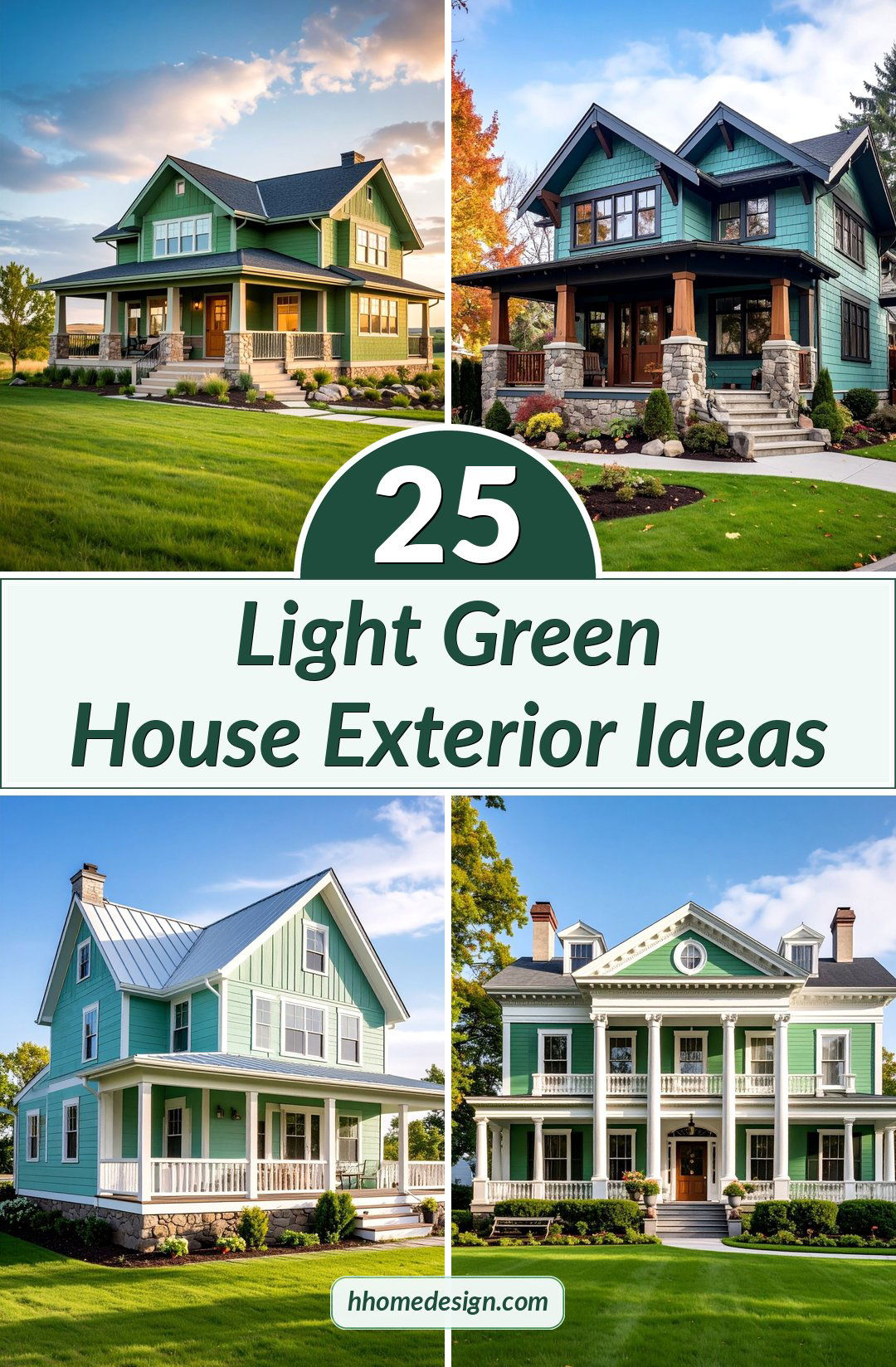
1. Sage Green Cottage with White Trim
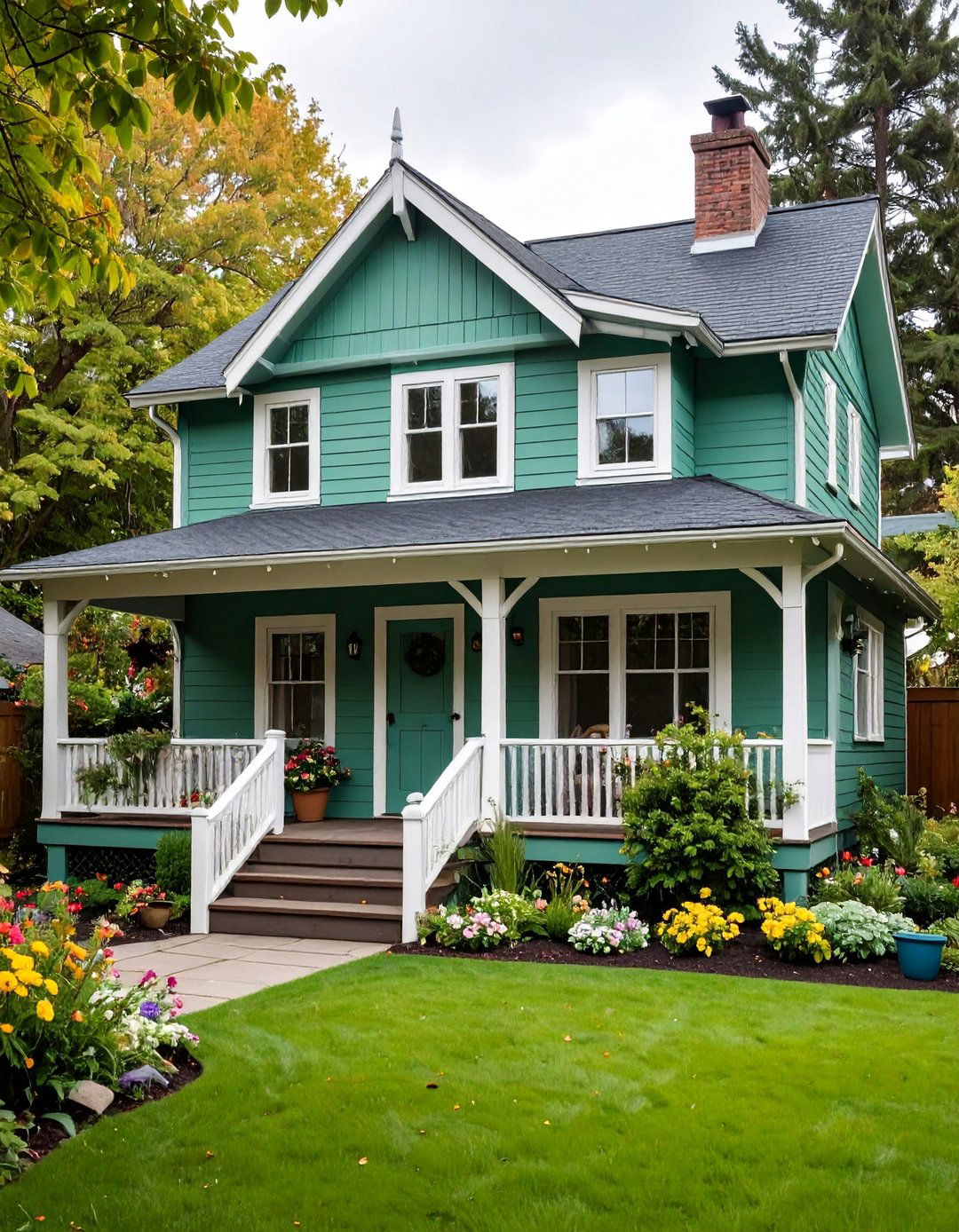
A charming cottage featuring soft sage green siding creates an instantly calming exterior that feels both timeless and fresh. The muted green pairs beautifully with crisp white window frames, shutters, and decorative trim work that highlights architectural details. This classic combination works particularly well on smaller homes where the gentle color doesn't overwhelm the structure. Natural wood elements like porch railings or front doors add warmth against the cool-toned sage. The overall effect provides a sophisticated country aesthetic that blends seamlessly with garden landscapes and surrounding greenery for perfect harmony.
2. Mint Green Craftsman Bungalow
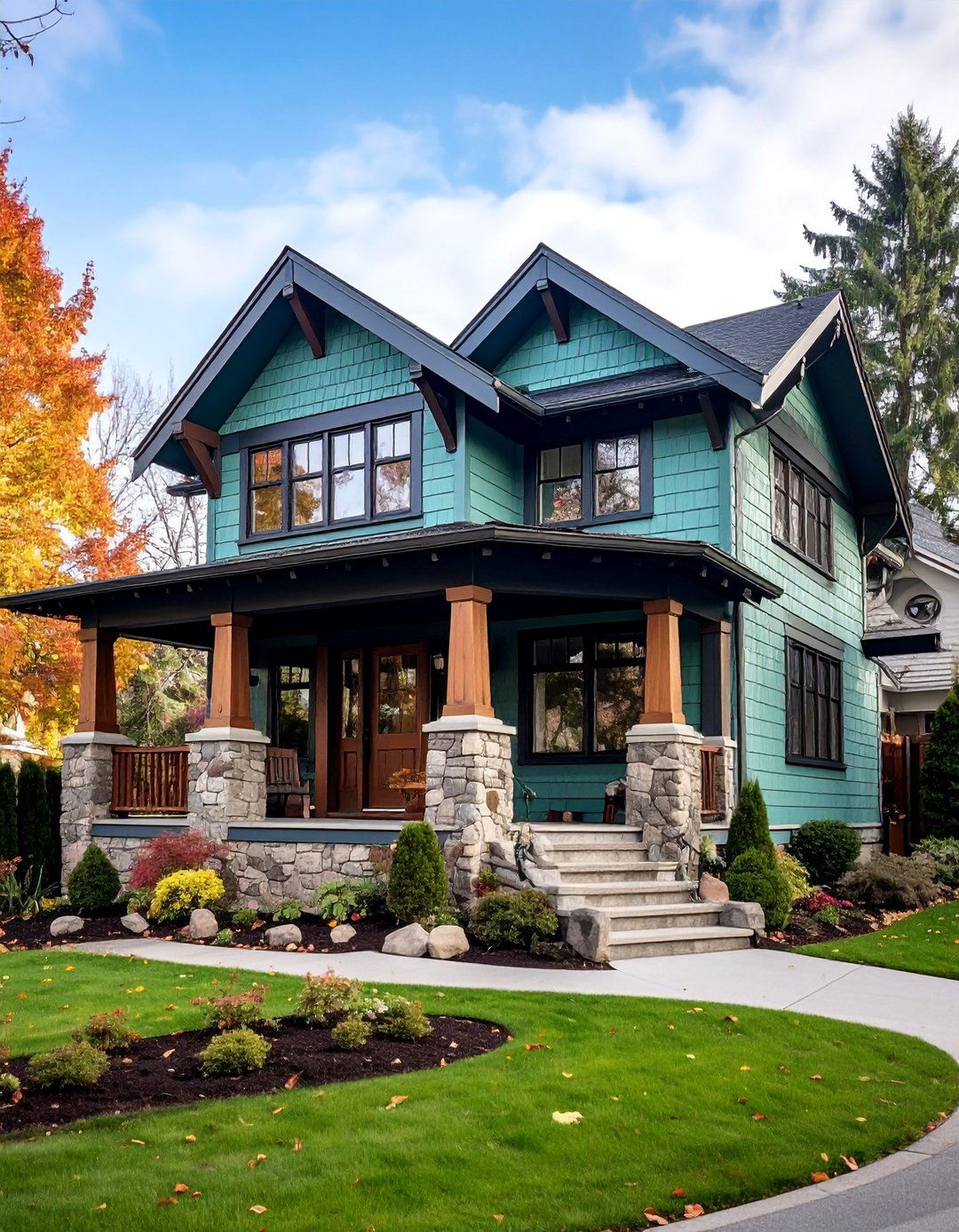
Transform a Craftsman-style home with refreshing mint green siding that celebrates the architectural movement's connection to nature. The pale green tone emphasizes the horizontal lines characteristic of bungalow design while maintaining the style's earthy authenticity. Dark bronze or forest green trim creates beautiful contrast around windows and doors, highlighting the home's handcrafted details. Natural stone foundations and wooden porch columns complement the mint exterior perfectly. This color choice works especially well in suburban neighborhoods where the soft green provides personality without being overwhelming, creating welcoming curb appeal year-round.
3. Seafoam Green Beach House
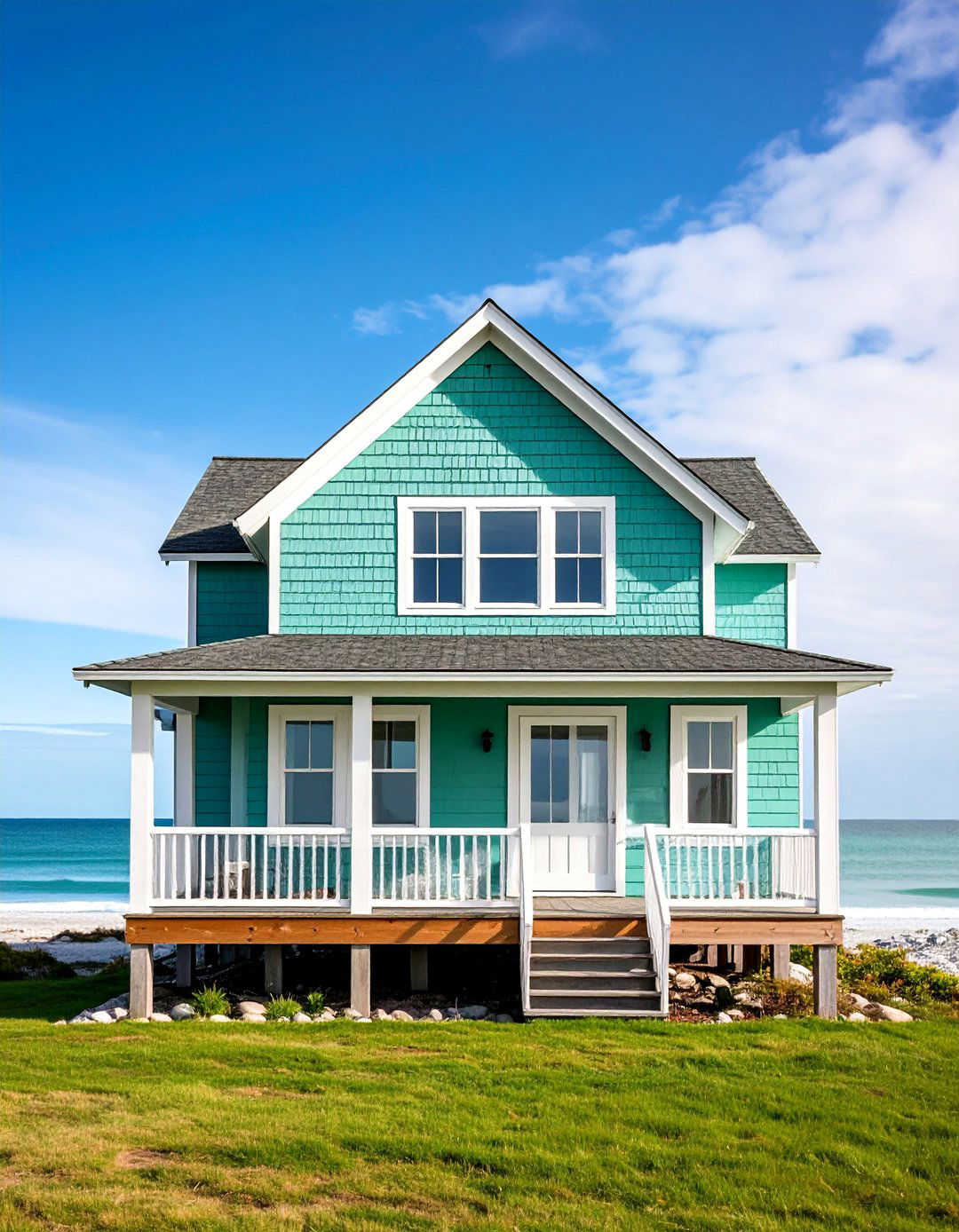
Create a coastal paradise with seafoam green exterior siding that captures the essence of ocean waves and sea glass. This pale blue-green hue works magnificently on beach houses and coastal cottages, especially when paired with weathered wood accents and white trim. The color reflects natural light beautifully, making homes appear larger and more inviting. Consider adding natural cedar shingles as accent materials or incorporating coral-colored front doors for a playful coastal touch. Large windows framed in white allow the seafoam exterior to flow seamlessly with ocean views, creating a tranquil retreat atmosphere.
4. Light Green Victorian with Gingerbread Trim
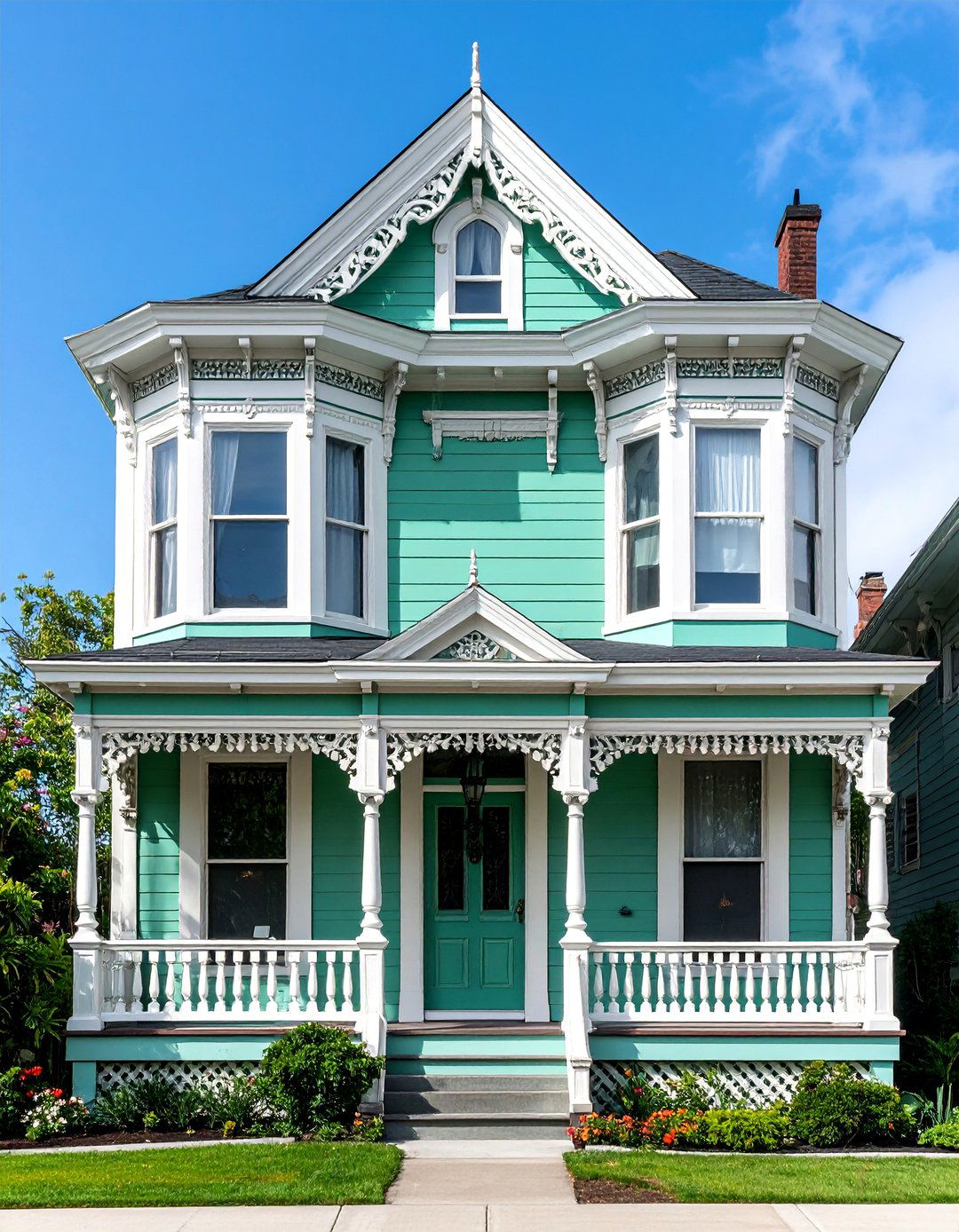
Embrace Victorian elegance with soft light green siding that showcases ornate architectural details without overwhelming the decorative elements. This historical color choice pairs beautifully with intricate white gingerbread trim, allowing the detailed woodwork to stand out dramatically. Consider adding deeper green or burgundy accent colors on shutters or doors to create visual depth. The light green base provides a sophisticated backdrop for the home's elaborate features while maintaining the period's romantic charm. Bay windows, wrap-around porches, and decorative brackets all benefit from this gentle color choice that celebrates architectural craftsmanship.
5. Modern Sage Green with Black Accents
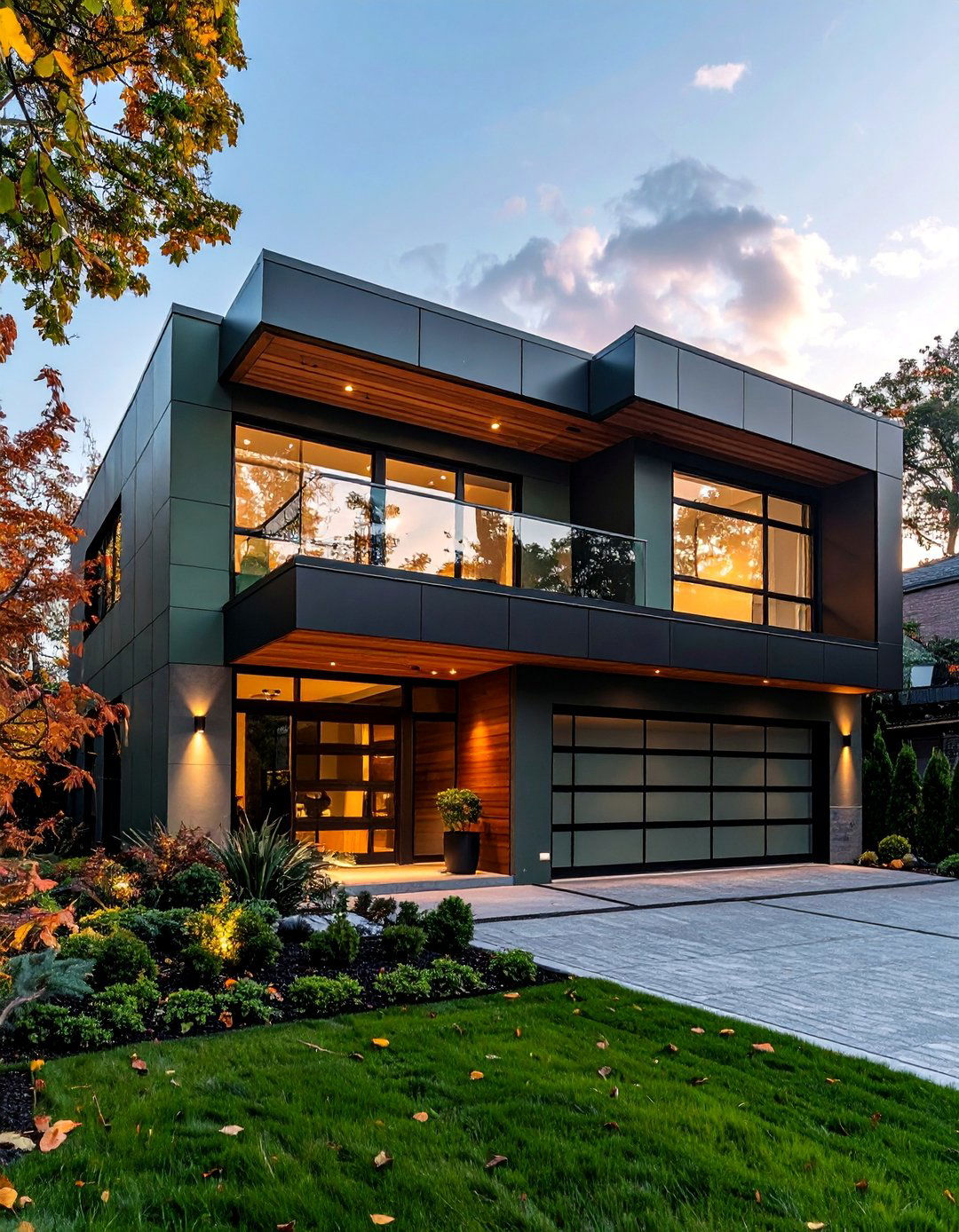
Contemporary homes gain sophisticated edge with sage green siding paired with bold black window frames and trim. This striking combination creates clean lines that emphasize modern architectural elements while maintaining connection to natural surroundings. The muted green softens the stark contrast between black and white, providing warmth that pure monochrome schemes often lack. Consider adding natural wood elements like garage doors or entry features to balance the palette. This color scheme works particularly well on geometric home designs where the sage green humanizes angular architecture while black accents add dramatic definition.
6. Light Green Farmhouse with Stone Foundation
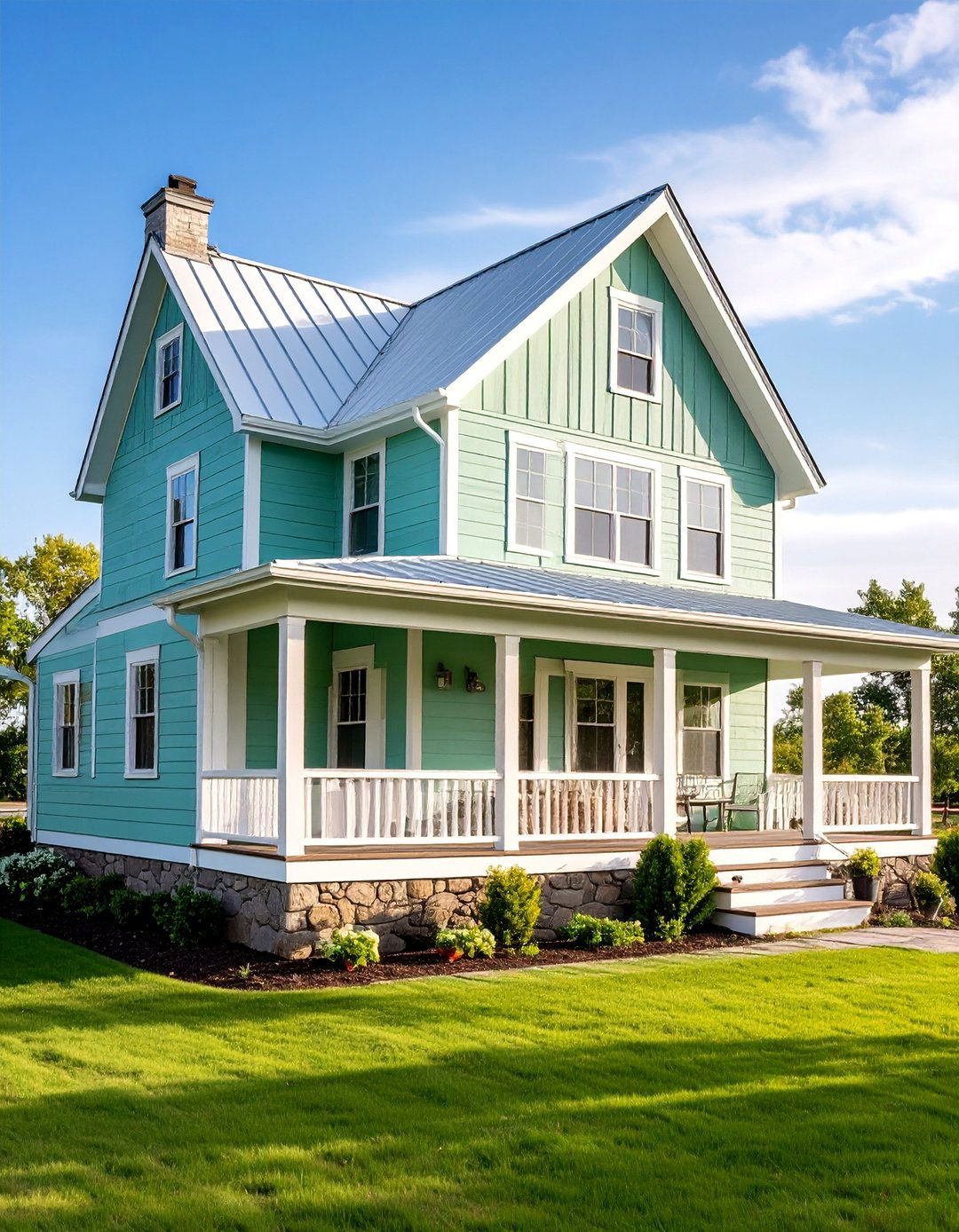
Rustic farmhouse charm emerges when light green board-and-batten siding tops natural stone foundations. This combination creates beautiful texture contrast while maintaining the style's connection to agricultural heritage. The pale green works harmoniously with weathered wood elements like barn doors, porch posts, and window boxes filled with seasonal plantings. White trim around windows and doors provides crisp definition that prevents the exterior from appearing too casual. This design approach works especially well in rural settings where the green exterior blends naturally with surrounding landscapes and mature trees.
7. Mint Green Colonial with Symmetrical Design

Traditional Colonial architecture gains fresh appeal with mint green siding that maintains the style's formal symmetry while adding contemporary personality. The structured window placement and centered front door characteristic of Colonial design benefit from this soft color choice that doesn't compete with architectural proportions. Classic white trim and black shutters create the traditional three-color scheme that defines the style. Consider adding brass hardware and lighting fixtures that complement the green undertones. This approach updates historical design for modern living while respecting the architectural integrity that makes Colonial homes timelessly appealing.
8. Seafoam Green Cottage with Copper Accents
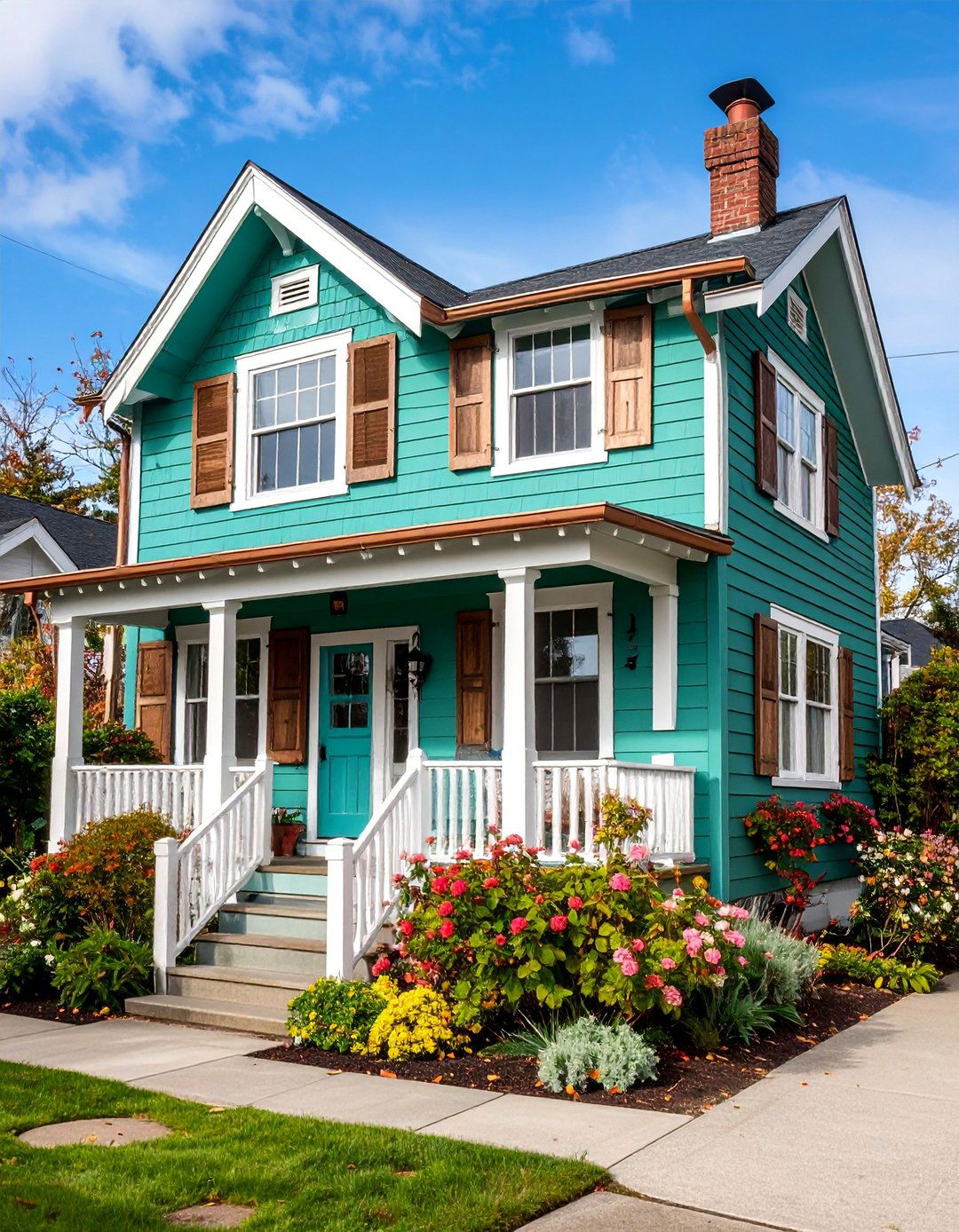
Coastal cottage charm reaches new heights with seafoam green siding complemented by warm copper accents on gutters, downspouts, and light fixtures. This sophisticated color combination creates beautiful patina contrast as copper naturally ages to develop rich verdigris tones that harmonize with the green exterior. White trim around windows and doors keeps the palette fresh and bright, while natural wood shutters add texture and warmth. The overall effect captures seaside elegance that feels both casual and refined, perfect for homes near water or those wanting to evoke coastal living year-round.
9. Light Green Stucco Mediterranean Style

Mediterranean architecture gains fresh interpretation with light green stucco walls that provide sophisticated alternative to traditional earth tones. The smooth stucco texture allows the gentle green to appear more saturated while maintaining the style's connection to natural surroundings. Terra cotta tile roofing creates beautiful warm contrast against the cool-toned walls, while wrought iron details add architectural authenticity. Consider incorporating natural stone accents around windows and doorways to enhance the Mediterranean aesthetic. This color choice works particularly well in warm climates where the green exterior provides cooling visual effect while maintaining cultural architectural integrity.
10. Sage Green Cape Cod with Cedar Shingles
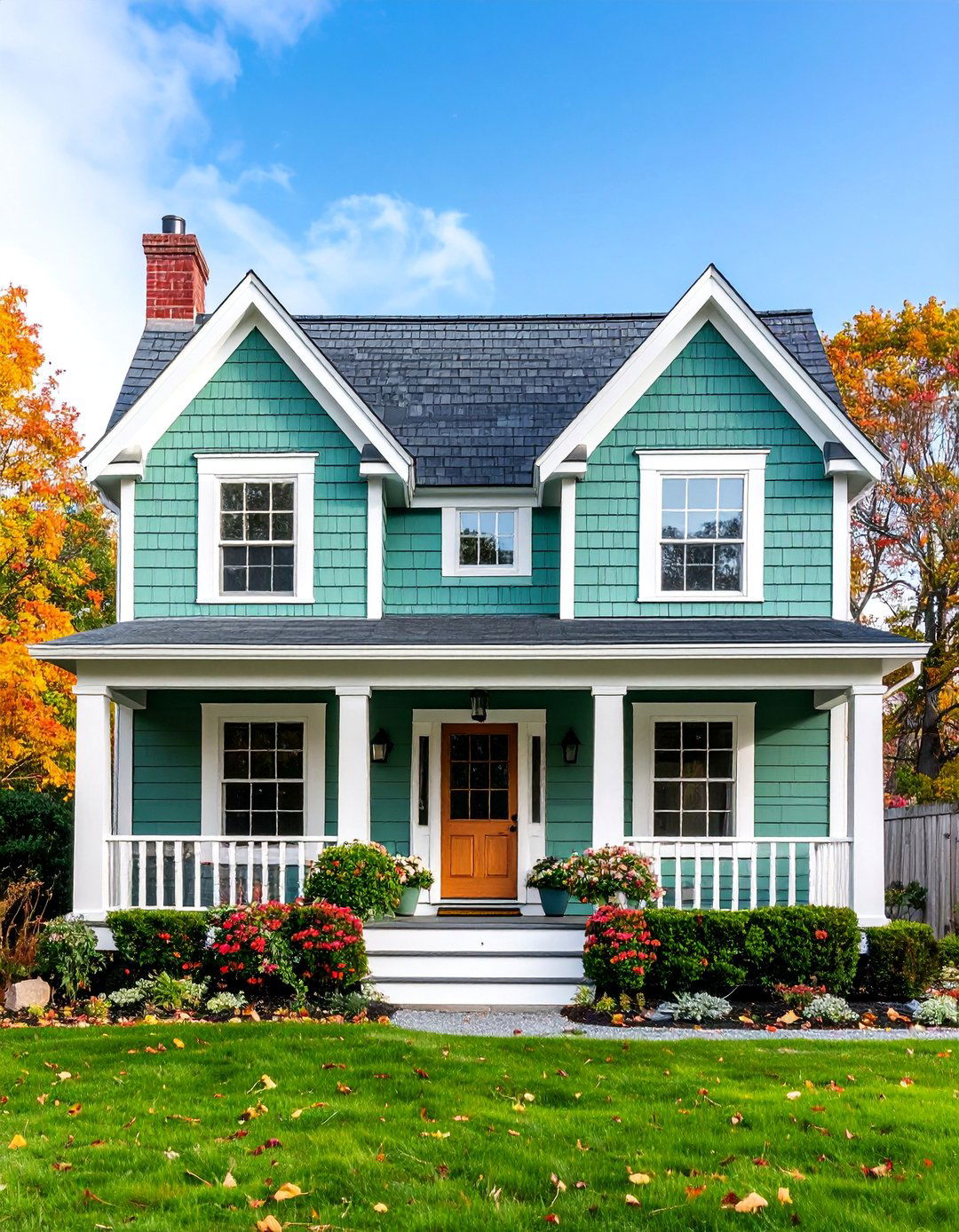
Classic Cape Cod architecture benefits from sage green cedar shingle siding that enhances the style's New England heritage while providing contemporary sophistication. The natural texture of cedar shingles allows the green stain to appear richly dimensional, creating beautiful curb appeal that improves with weather exposure. White trim around dormer windows and front doors maintains the traditional aesthetic while crisp contrast prevents the exterior from appearing too muted. Consider adding natural wood elements like shutters or porch railings to complement the cedar texture. This timeless combination works beautifully in both coastal and inland settings.
11. Light Green Ranch with Horizontal Siding

Mid-century ranch homes gain renewed appeal with light green horizontal siding that emphasizes the style's characteristic long, low lines. This color choice softens the sometimes stark appearance of ranch architecture while maintaining its clean, uncluttered aesthetic. Natural wood elements like garage doors and entry features add warmth against the pale green exterior. Consider incorporating large planters with architectural plants to enhance the home's connection to landscape design. White or cream trim keeps the palette fresh while allowing the green to remain the focal point of this understated yet sophisticated exterior treatment.
12. Mint Green Scandinavian Minimalist

Embrace Nordic design principles with mint green siding that creates serene, uncluttered exteriors characteristic of Scandinavian architecture. The pale green works beautifully with white trim and natural wood accents, creating the light, airy feeling central to this design philosophy. Simple geometric forms benefit from this gentle color that doesn't compete with clean architectural lines. Consider adding blonde wood elements around entries or as accent panels to enhance the Nordic aesthetic. Large windows framed in white allow natural light to complement the mint exterior, creating homes that feel connected to nature while maintaining sophisticated simplicity.
13. Light Green Tudor with Half-Timbering
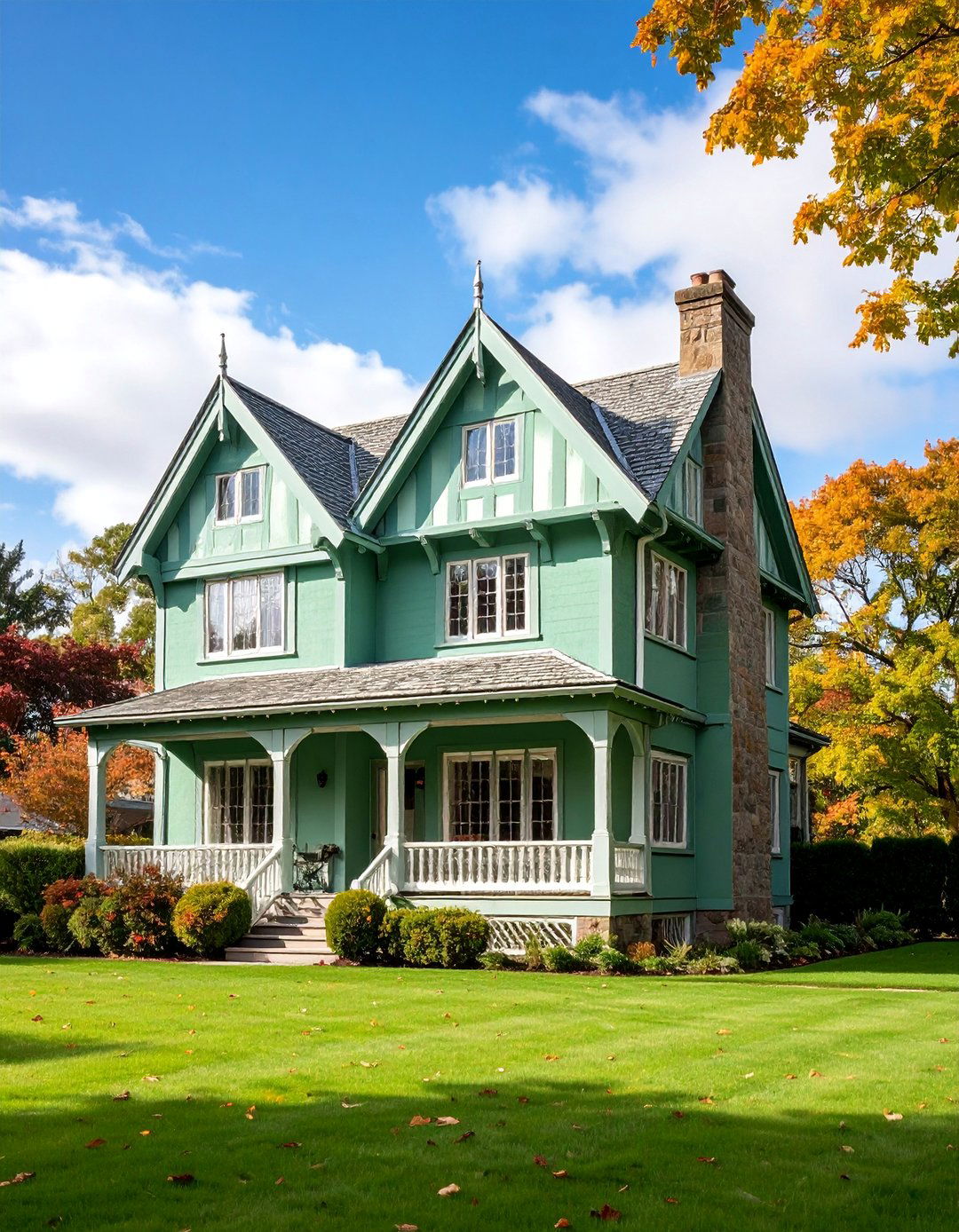
Tudor Revival architecture gains fresh personality with light green stucco between dark timber framing that creates striking visual contrast. This color choice provides sophisticated alternative to traditional cream or white stucco while maintaining the style's medieval-inspired character. The green works particularly well with natural wood elements, creating harmony between structural and decorative features. Consider using slightly darker green tones for accent areas like gables or bay windows to add depth. This approach updates historical design for contemporary tastes while respecting the architectural elements that make Tudor homes distinctively charming and character-rich.
14. Seafoam Green Bungalow with Natural Stone
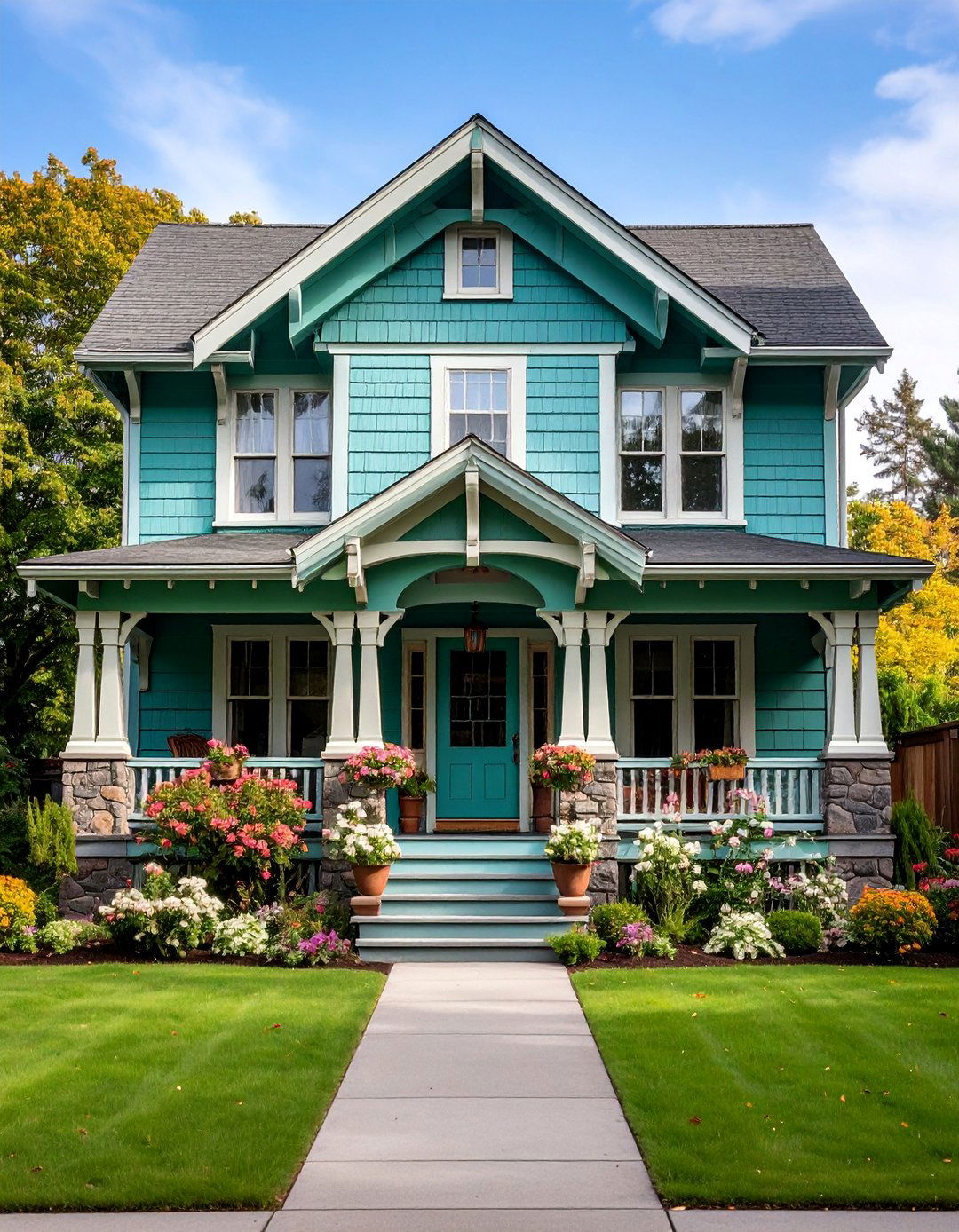
Arts and Crafts bungalows benefit tremendously from seafoam green siding paired with natural stone foundations and accent walls. This combination celebrates the movement's emphasis on natural materials while providing fresh color interpretation. The pale blue-green works harmoniously with warm stone tones, creating beautiful contrast that emphasizes both materials. Consider adding copper or bronze hardware and lighting fixtures that complement both the green siding and stone elements. Wide front porches characteristic of bungalow design become even more inviting when framed by this sophisticated color palette that connects architecture with natural surroundings.
15. Light Green French Country with Limestone Accents
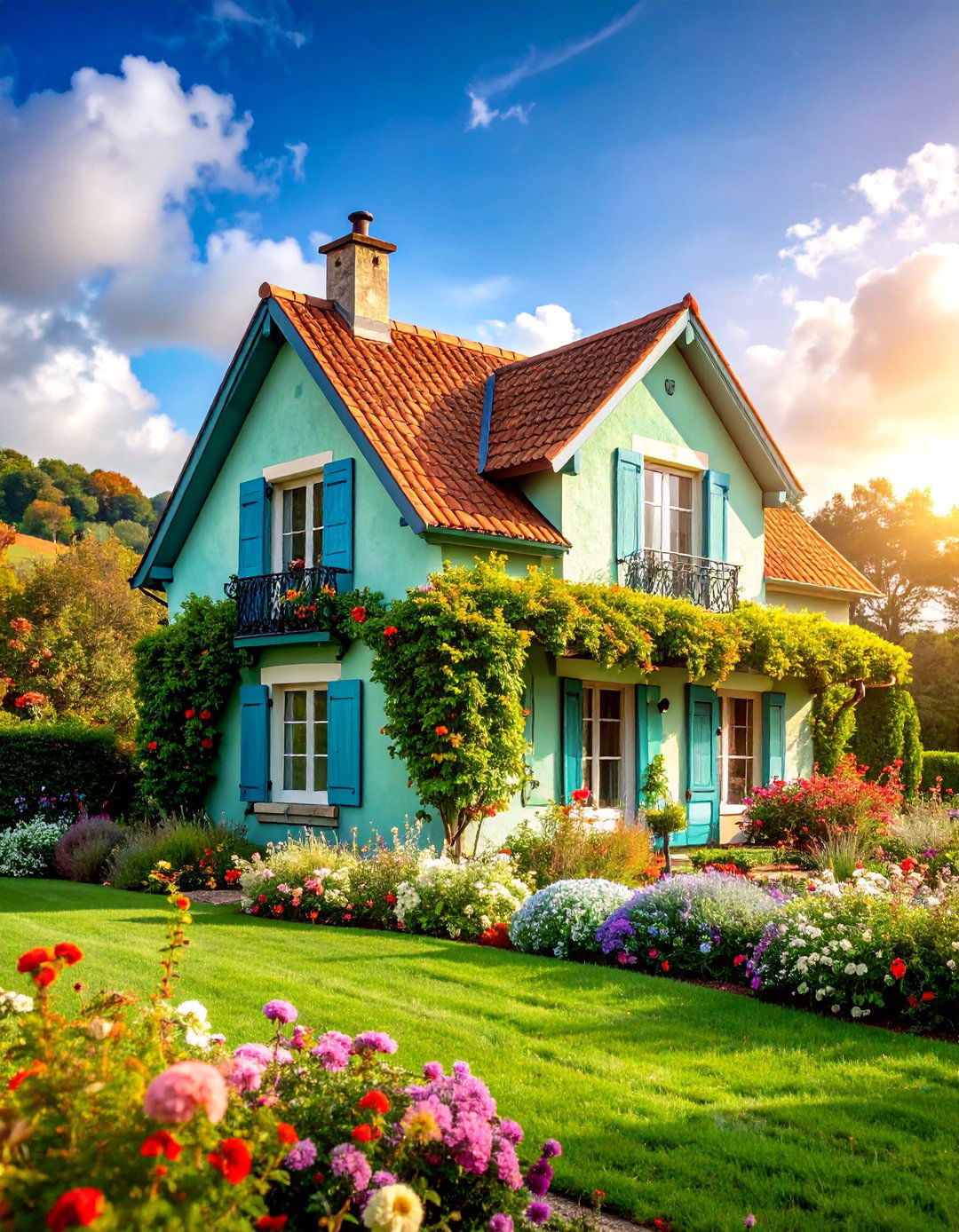
French Country architecture achieves romantic elegance with light green stucco walls complemented by natural limestone accents around windows, doors, and architectural details. This sophisticated color combination creates the refined casual aesthetic central to French design while providing fresh interpretation of traditional earth tones. Consider adding wrought iron elements and copper roofing details that enhance the European character. Formal gardens and structured landscaping complement this color scheme beautifully, creating exteriors that feel both elegant and approachable. The light green provides perfect backdrop for seasonal plantings and decorative elements that define French Country charm.
16. Sage Green Contemporary with Geometric Elements
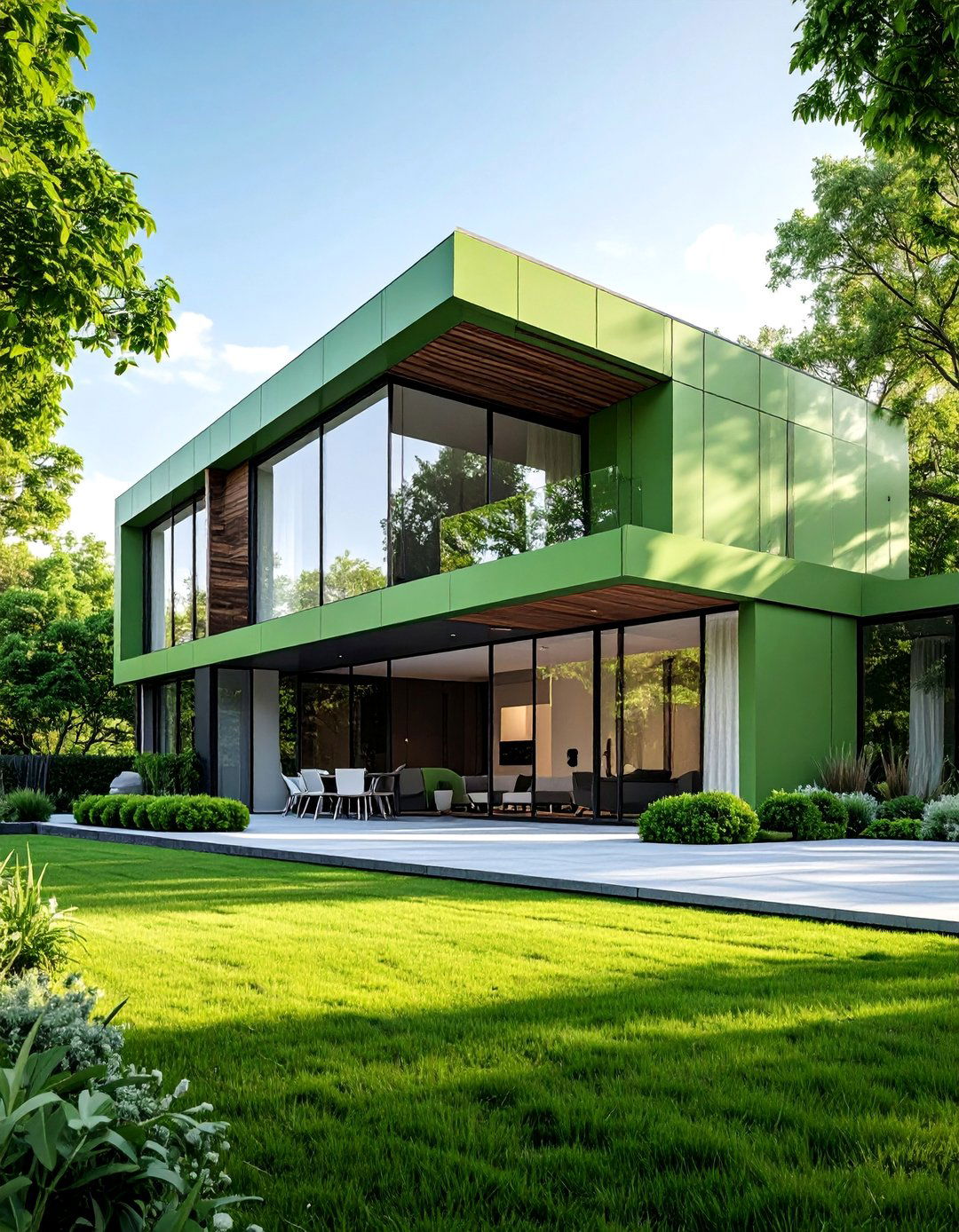
Modern contemporary homes gain sophisticated depth with sage green siding that softens angular architectural elements while maintaining clean, uncluttered aesthetics. This muted color works beautifully with geometric design features, providing warmth that pure white or gray schemes often lack. Consider incorporating natural wood elements as accent panels or screening to enhance the contemporary feel. Large expanses of glass benefit from green framing that connects interior and exterior spaces naturally. This color choice works particularly well on homes with strong horizontal lines or interesting geometric forms where the sage green enhances rather than competes with architectural innovation.
17. Mint Green Shingle Style with Wraparound Porch
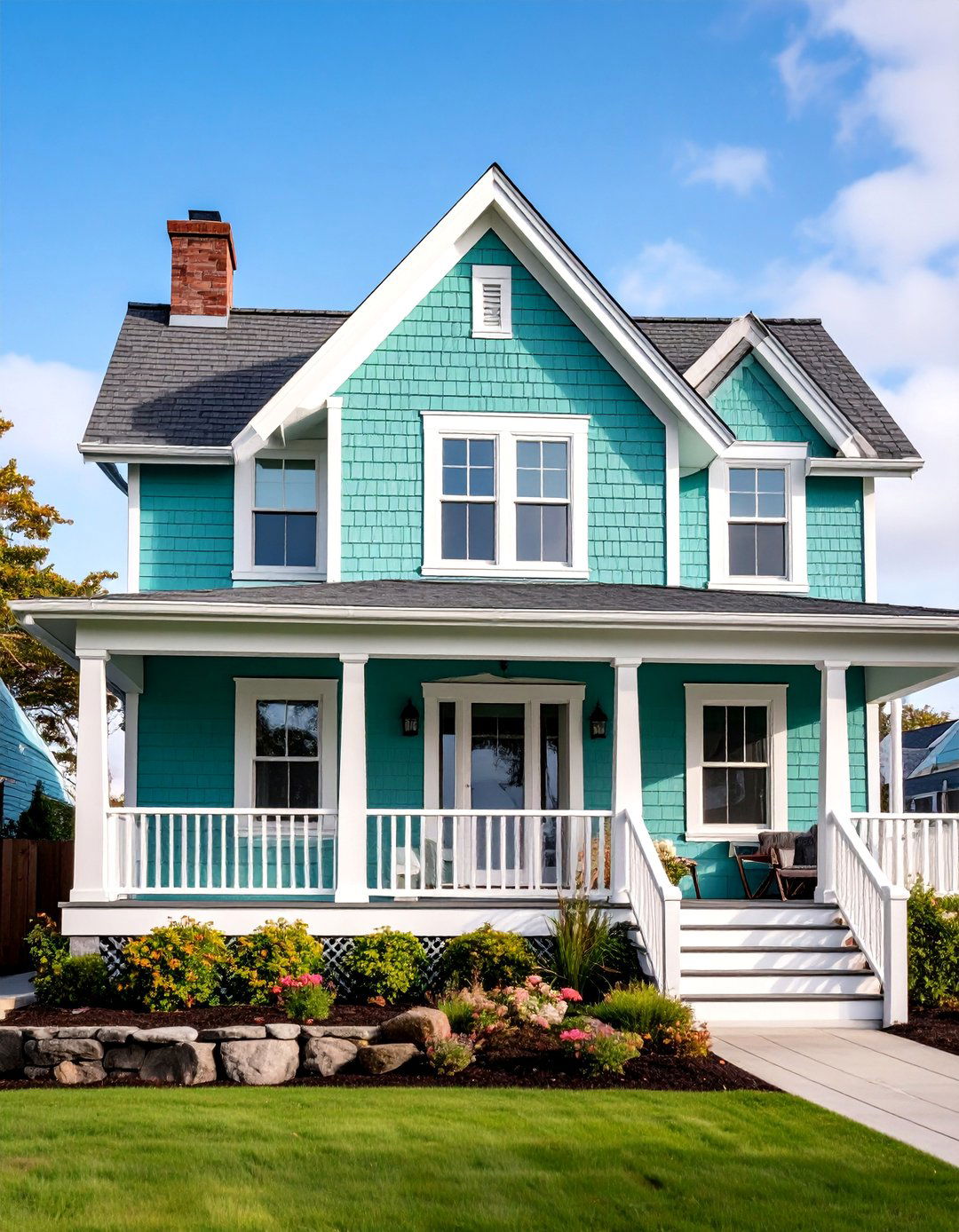
Shingle Style architecture reaches new sophistication with mint green cedar shingles that create beautiful texture while maintaining the style's casual elegance. Wide wraparound porches characteristic of this design become even more inviting when framed by soft green shingles and white trim details. The natural texture of cedar allows the mint stain to appear richly dimensional, improving with weather exposure. Consider adding white wicker furniture and seasonal plantings to enhance the relaxed aesthetic. This color combination works beautifully in both coastal and suburban settings where the green exterior creates welcoming curb appeal year-round.
18. Light Green Prairie Style with Horizontal Lines

Prairie School architecture benefits from light green siding that emphasizes the style's characteristic horizontal lines while connecting homes to natural prairie landscapes. This earth-inspired color choice complements the movement's philosophy of architecture harmonizing with environment. Natural wood elements and stone accents work beautifully with green exteriors, creating the integrated design Frank Lloyd Wright championed. Consider adding copper or bronze details that develop natural patina over time. Wide overhanging eaves and grouped windows characteristic of Prairie style become even more dramatic when contrasted against light green siding that provides sophisticated backdrop for architectural innovation.
19. Seafoam Green Coastal Cottage with Weather-Resistant Materials

Beach cottages achieve perfect coastal charm with seafoam green fiber cement siding that withstands harsh weather while maintaining beautiful color integrity. This practical color choice provides the casual elegance essential to coastal design while offering superior durability compared to traditional wood siding. White trim and natural cedar accents create the relaxed aesthetic central to beach house design. Consider adding metal roofing in complementary tones and hurricane-resistant features that don't compromise style. This combination works beautifully for vacation homes or primary residences where the seafoam green creates year-round connection to ocean environments.
20. Light Green Federal Style with Classical Proportions
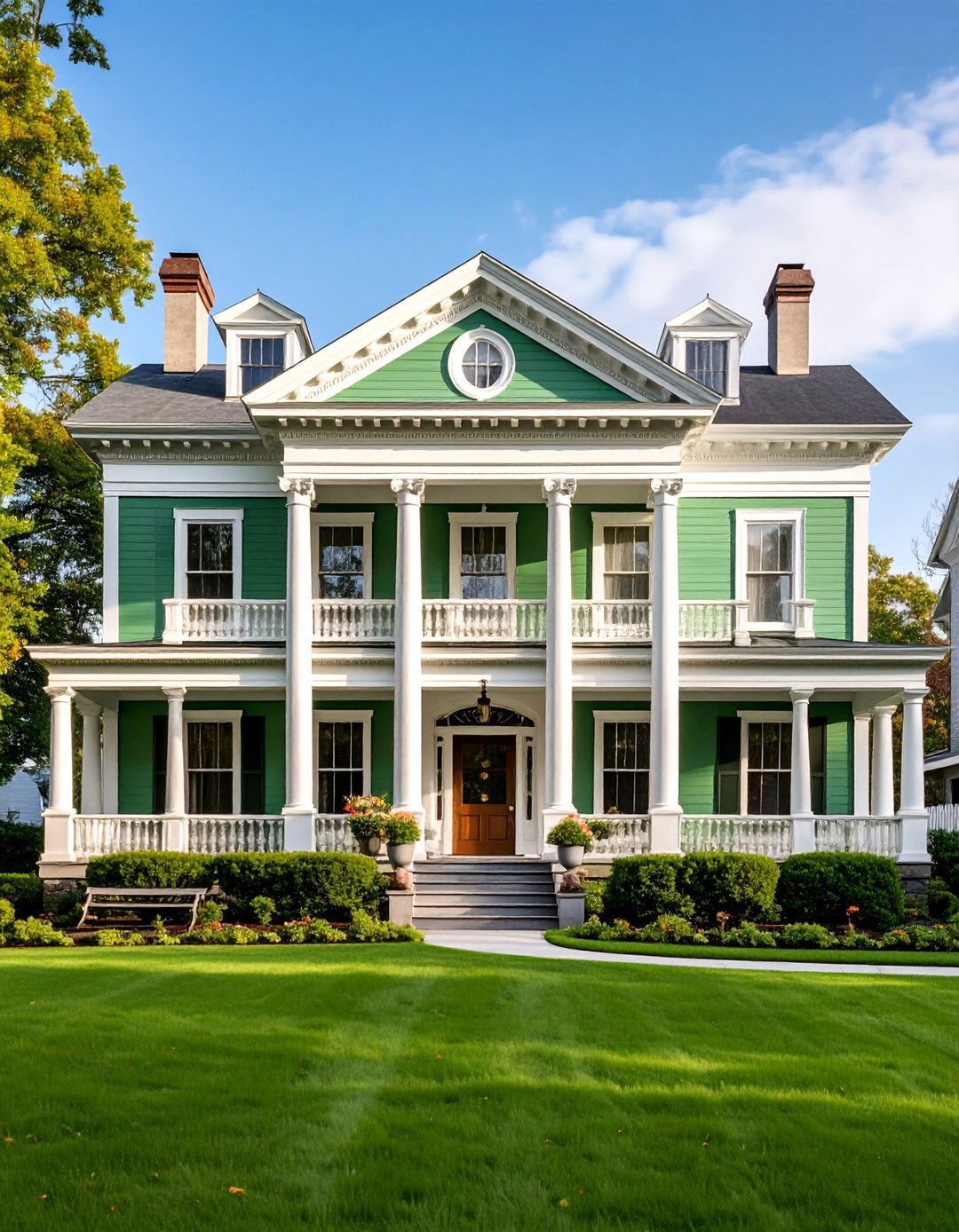
Federal architecture gains fresh sophistication with light green siding that maintains the style's classical proportions while providing contemporary color interpretation. The formal symmetry and refined details characteristic of Federal design benefit from this gentle color that doesn't compete with architectural elements. White trim around windows and doors creates the contrast essential to highlighting classical features. Consider adding brass hardware and lighting fixtures that complement the green undertones while maintaining historical authenticity. This approach updates early American design for modern living while respecting the architectural principles that make Federal homes timelessly elegant and distinguished.
21. Sage Green Adobe with Southwestern Flair
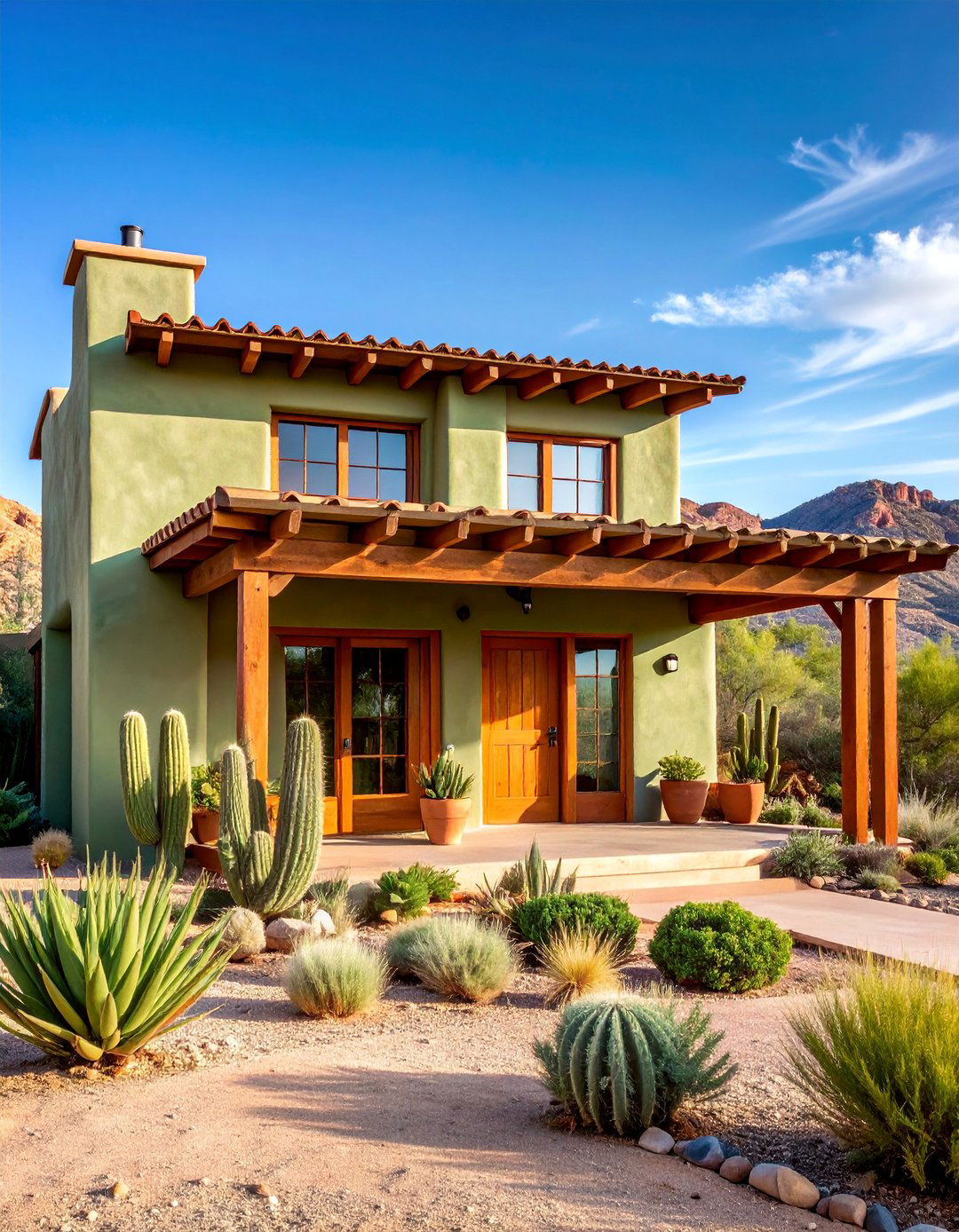
Southwestern architecture achieves sophisticated desert charm with sage green adobe walls that complement the region's natural vegetation while providing cooling visual effect. This earth-inspired color works beautifully with natural materials like exposed wooden beams, stone accents, and terra cotta roofing tiles. The muted green provides perfect backdrop for regional plants and desert landscaping that enhance the Southwestern aesthetic. Consider adding copper elements and rustic wood details that develop beautiful patina over time. This color choice creates homes that feel connected to desert environments while maintaining the architectural integrity central to regional design traditions.
22. Light Green Greek Revival with Columned Portico

Greek Revival architecture gains renewed elegance with light green siding that provides sophisticated backdrop for classical columns and pediments. This color choice maintains the style's formal dignity while offering fresh interpretation of traditional white schemes. The pale green works beautifully with white trim and classical architectural details, creating contrast that emphasizes proportion and symmetry. Consider adding period-appropriate lighting and hardware that complement the historical character. This approach updates antebellum design for contemporary living while respecting the architectural elements that make Greek Revival homes monumentally impressive and timelessly appealing to modern homeowners.
23. Mint Green Modernist with Clean Lines
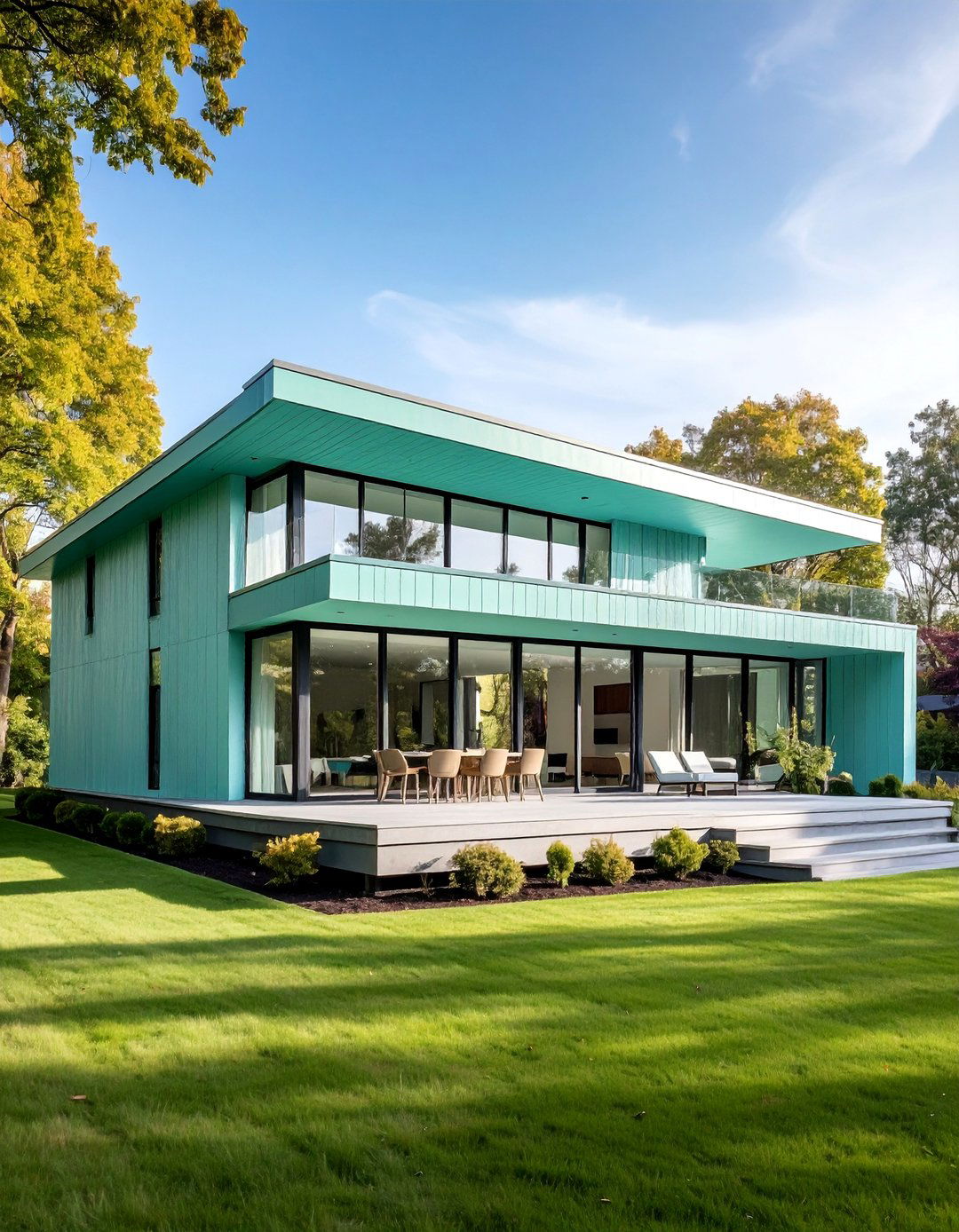
Mid-century Modernist architecture benefits from mint green siding that softens stark geometric forms while maintaining the style's emphasis on clean, uncluttered design. This color choice provides warmth that pure white or gray schemes often lack while respecting Modernist principles. Large expanses of glass and flat roofs characteristic of the style become more approachable when combined with gentle green exteriors. Consider adding natural wood elements and steel accents that enhance the period aesthetic. This combination works particularly well for homes with strong horizontal lines or interesting geometric forms where mint green humanizes innovative architecture without compromising design integrity.
24. Seafoam Green Queen Anne Victorian
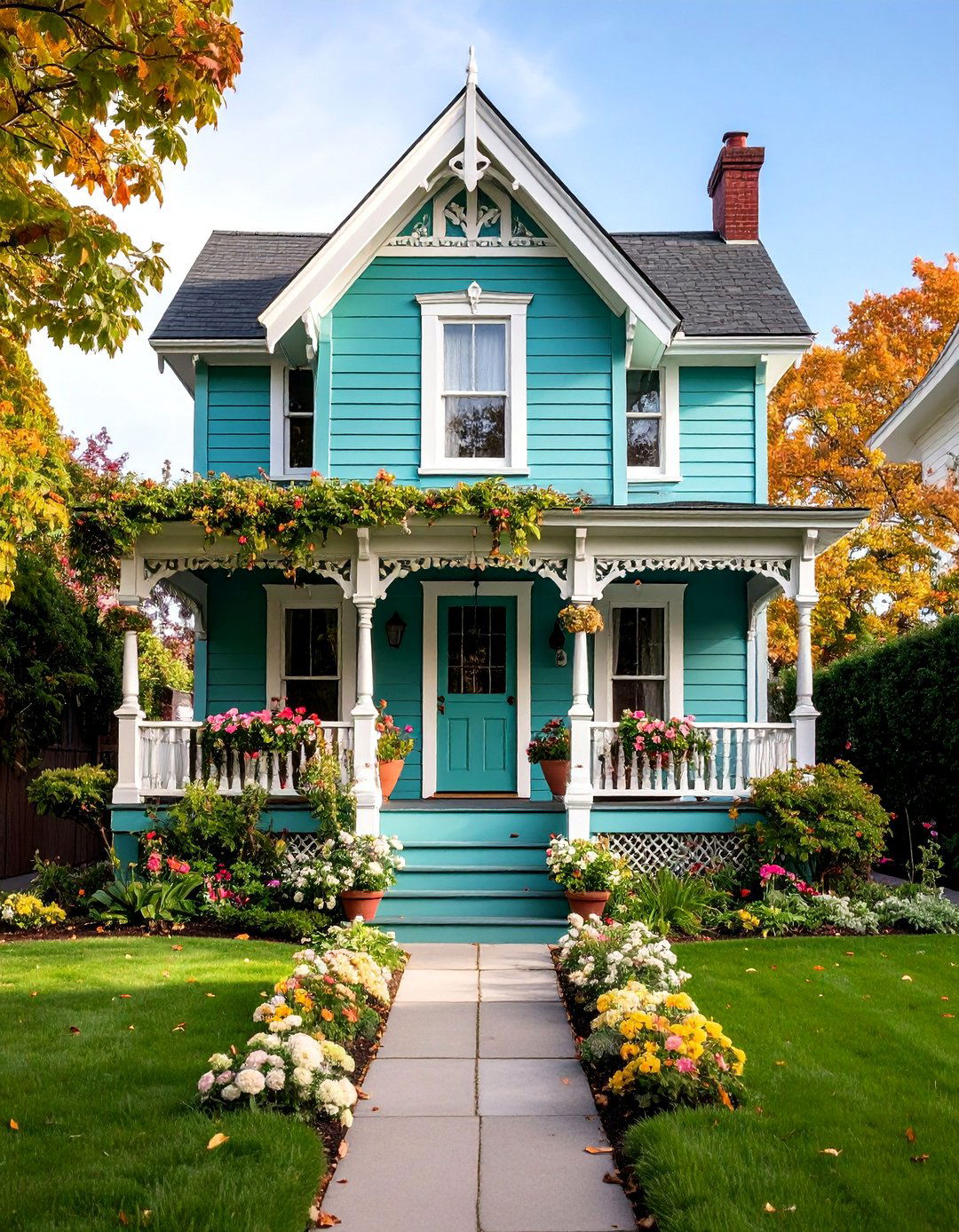
Queen Anne Victorian architecture achieves romantic sophistication with seafoam green siding that showcases ornate details without overwhelming decorative elements. This historical color choice provides fresh interpretation of period-appropriate schemes while maintaining the style's elaborate character. Intricate white trim and decorative brackets benefit from green backdrop that allows architectural details to stand out dramatically. Consider adding complementary accent colors on doors and shutters to enhance the Victorian aesthetic. This approach celebrates architectural craftsmanship while providing contemporary color interpretation that makes Queen Anne homes feel both historically authentic and surprisingly current for modern living.
25. Light Green Transitional with Mixed Materials
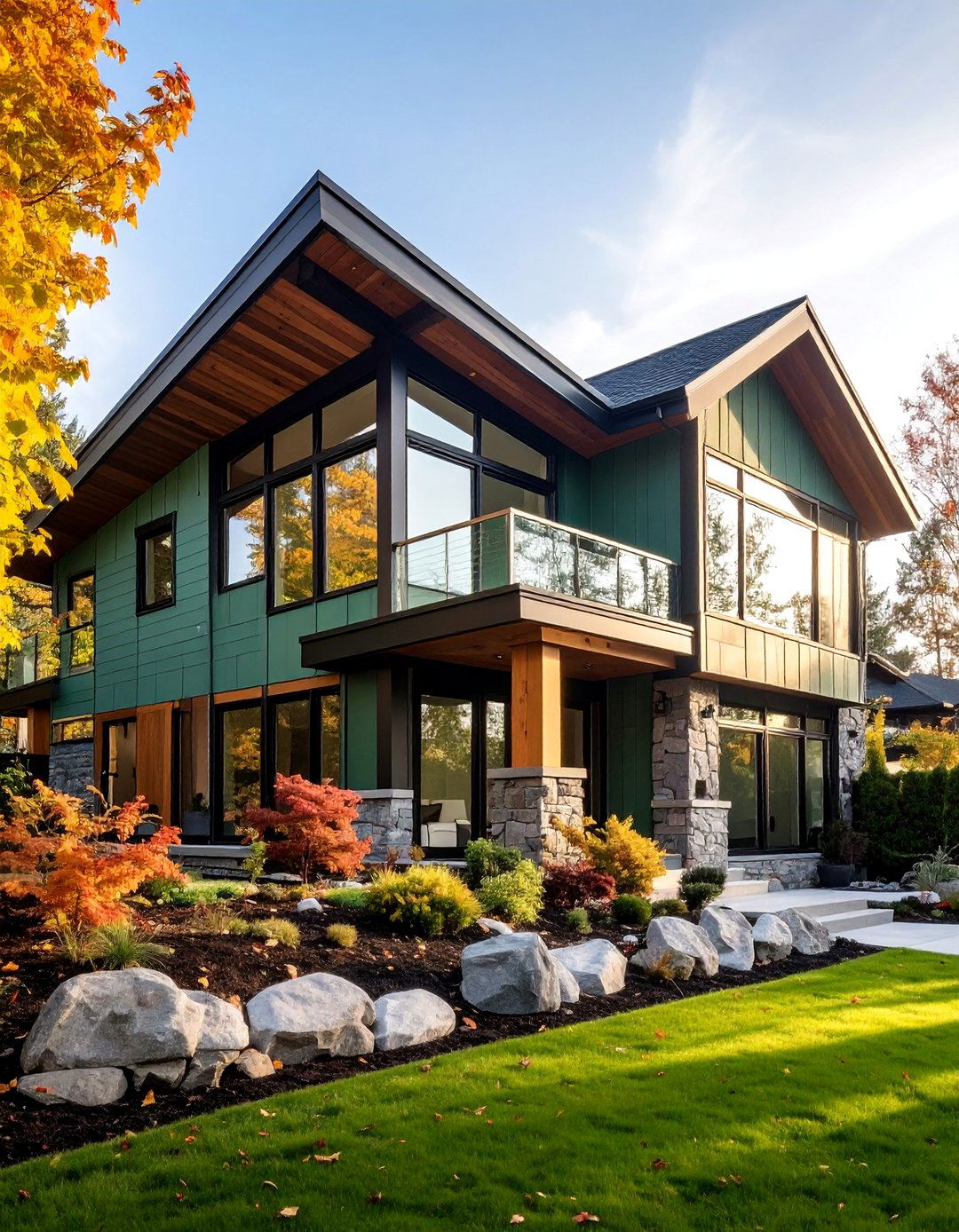
Transitional architecture achieves perfect balance with light green siding combined with natural stone, wood, and metal elements that create sophisticated contemporary exteriors. This versatile color works beautifully with mixed materials, providing unifying element that prevents eclectic combinations from appearing chaotic. The gentle green softens modern materials while enhancing natural elements like stone and wood. Consider incorporating energy-efficient features and sustainable materials that align with contemporary building practices. This color choice works particularly well for new construction that blends traditional and modern elements, creating homes that feel both current and timeless for lasting appeal.
Conclusion:
Light green house exteriors offer remarkable versatility for creating stunning, nature-inspired homes across all architectural styles. From sage green's sophisticated earthiness to mint's refreshing coastal charm, these hues provide timeless alternatives to conventional neutrals. The key lies in thoughtful material pairings and complementary trim colors that enhance rather than compete with the gentle green palette. Whether embracing cottage charm, contemporary minimalism, or classical elegance, light green exteriors create welcoming spaces that harmonize beautifully with natural surroundings while maintaining sophisticated curb appeal for years to come.


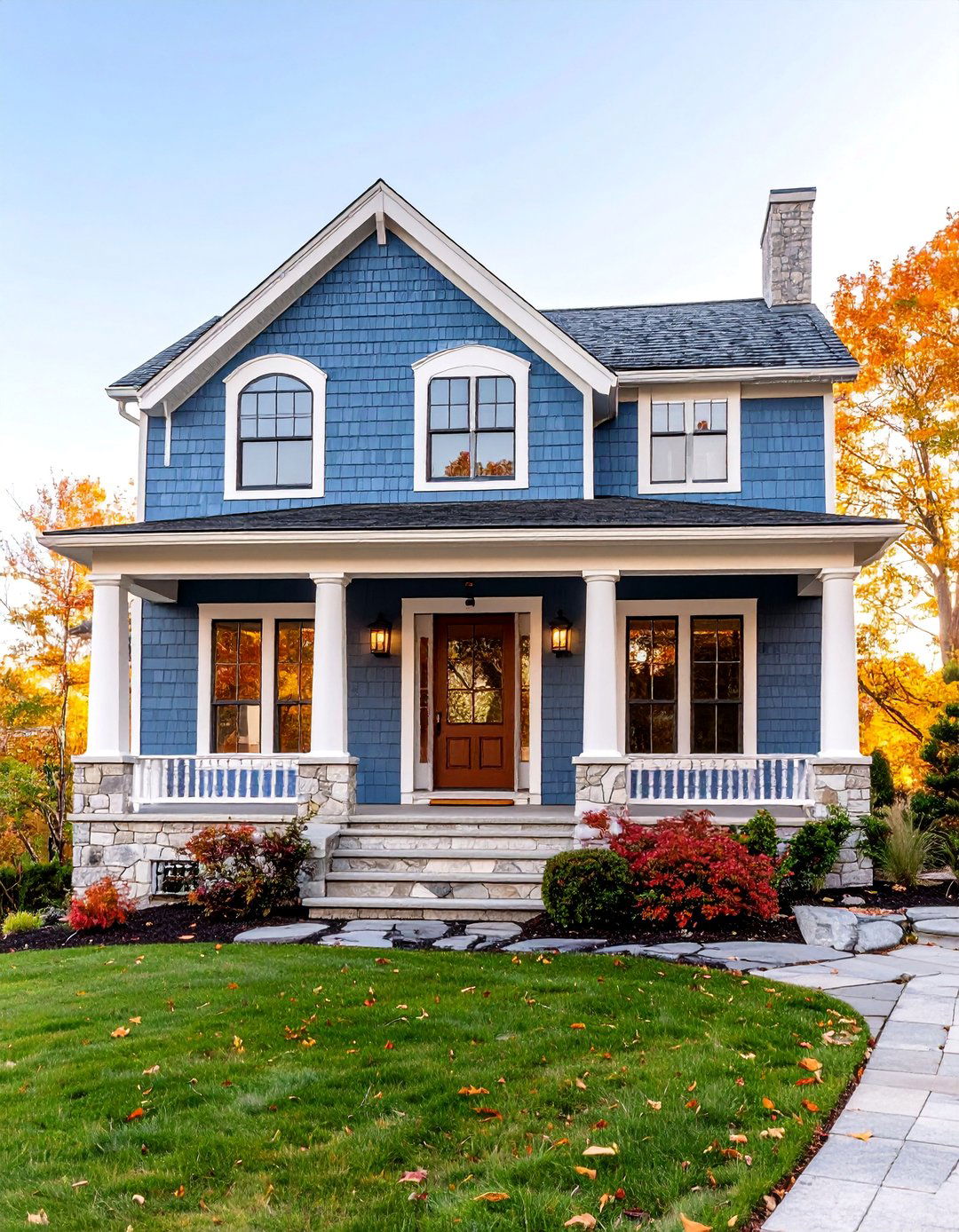
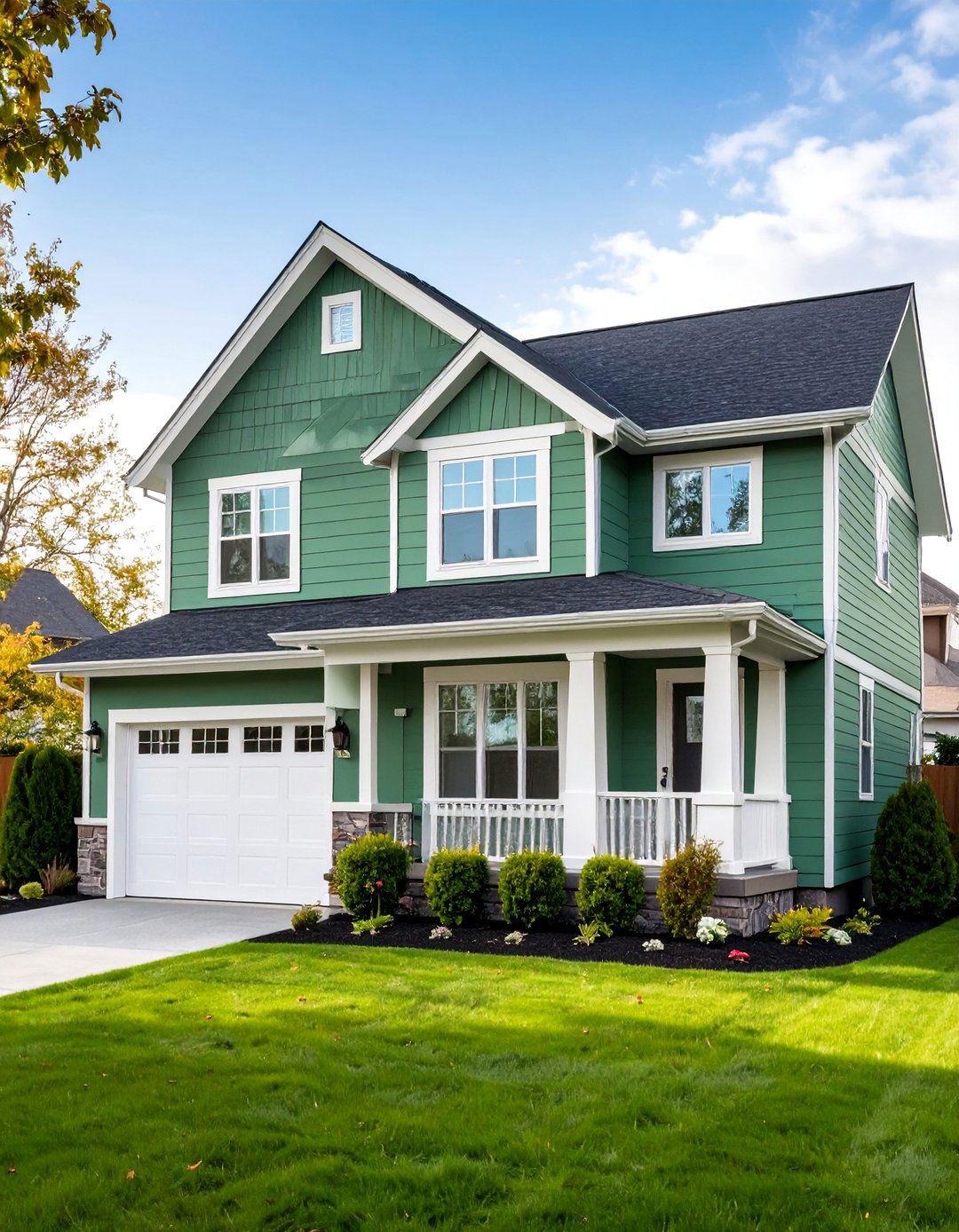
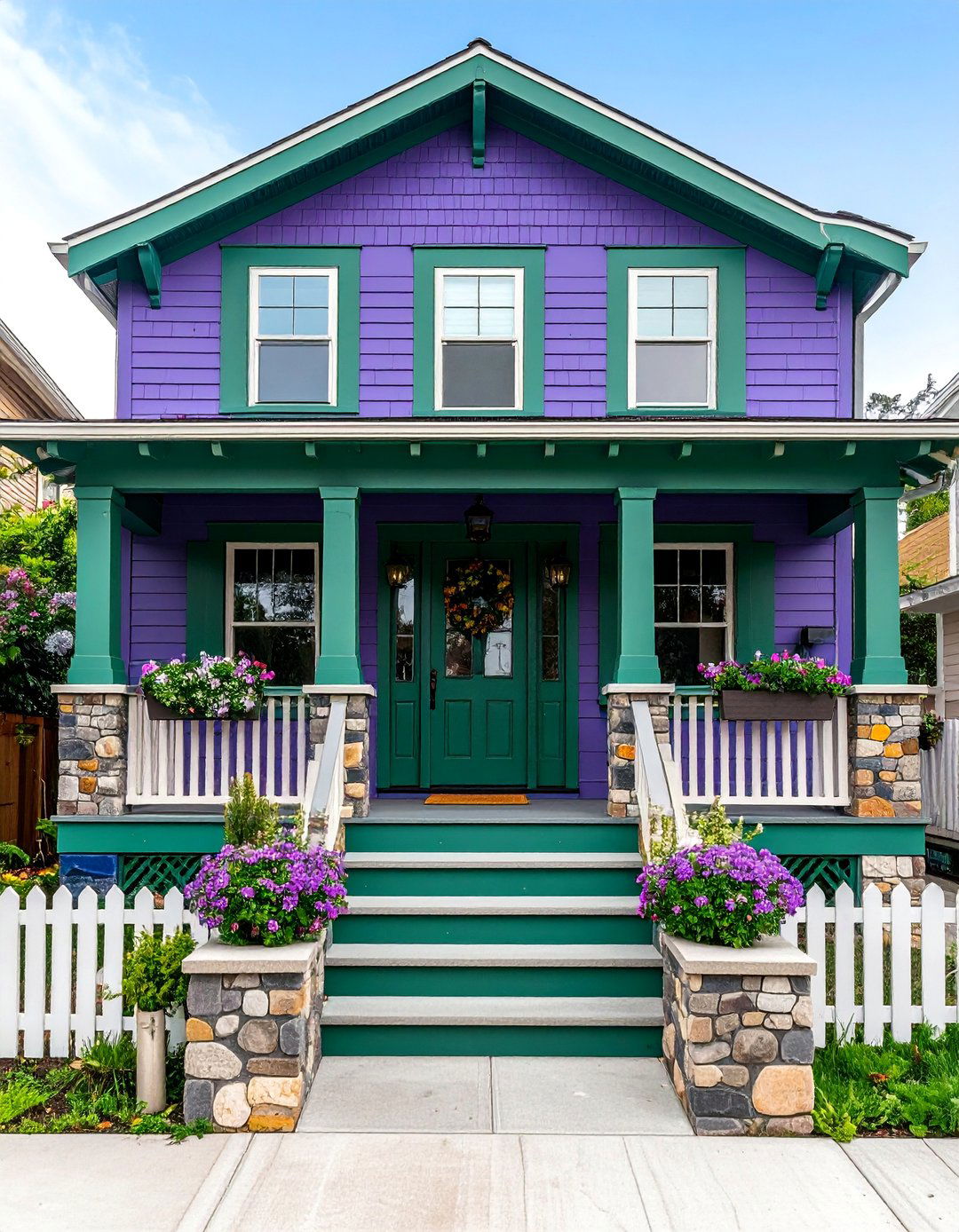



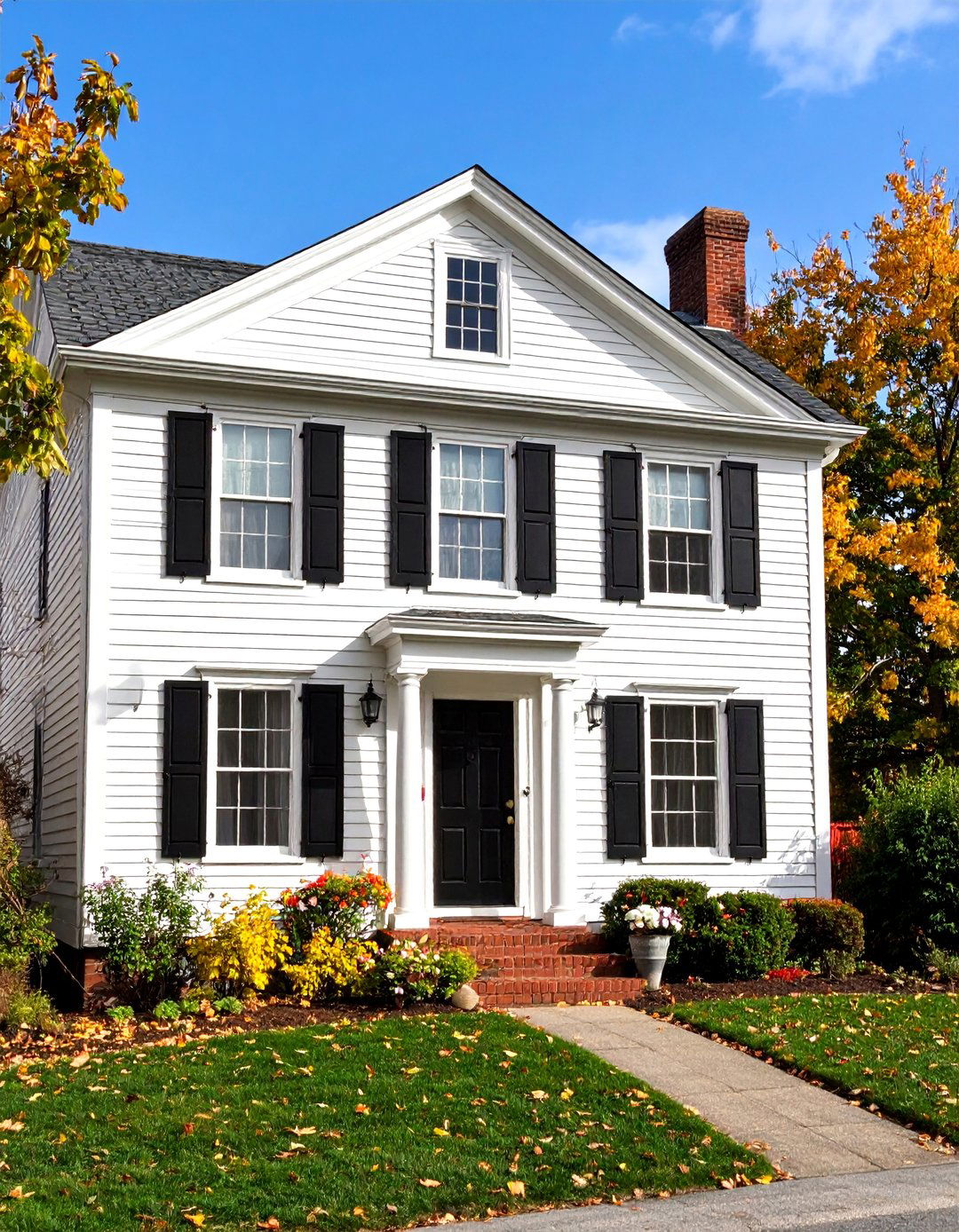
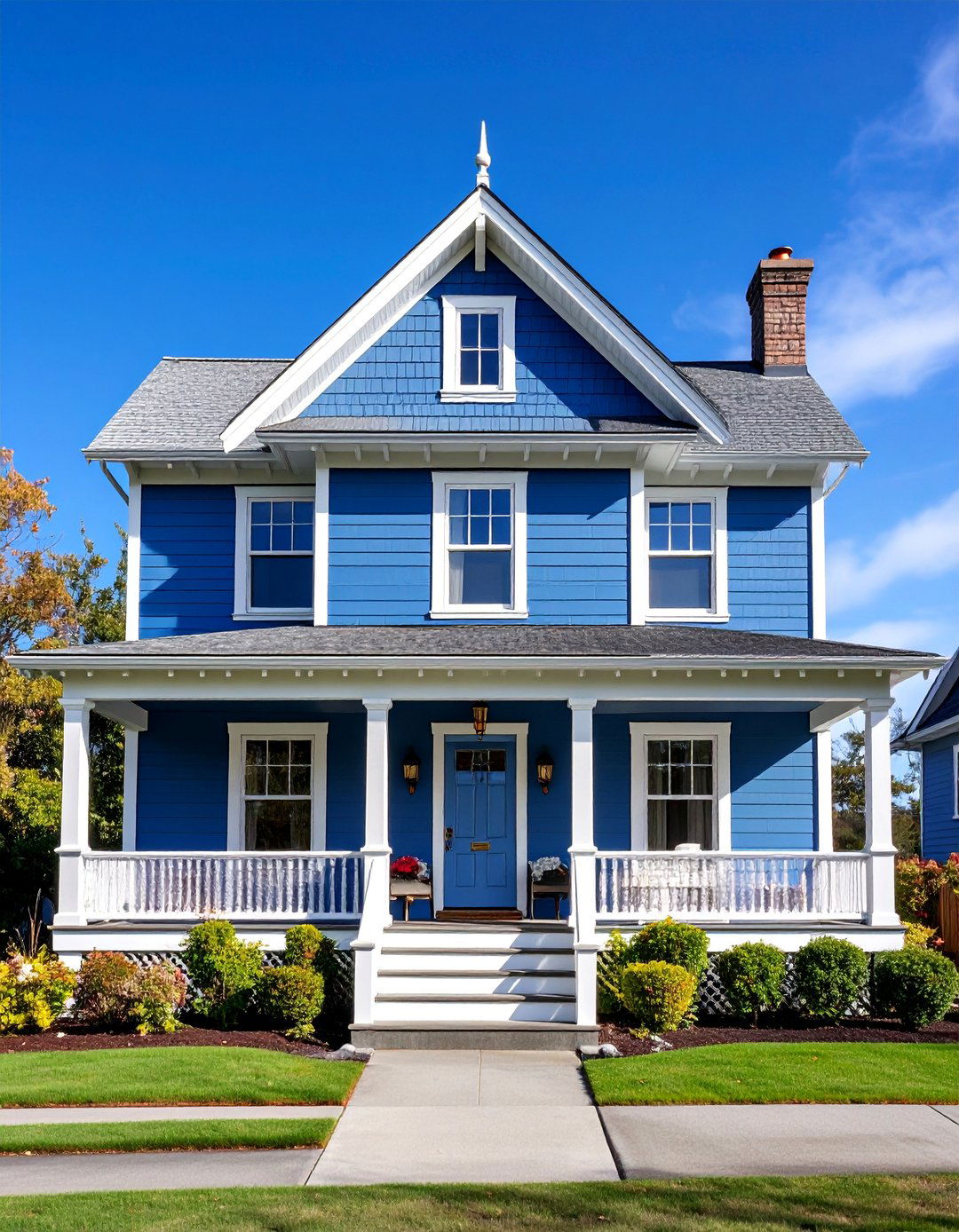

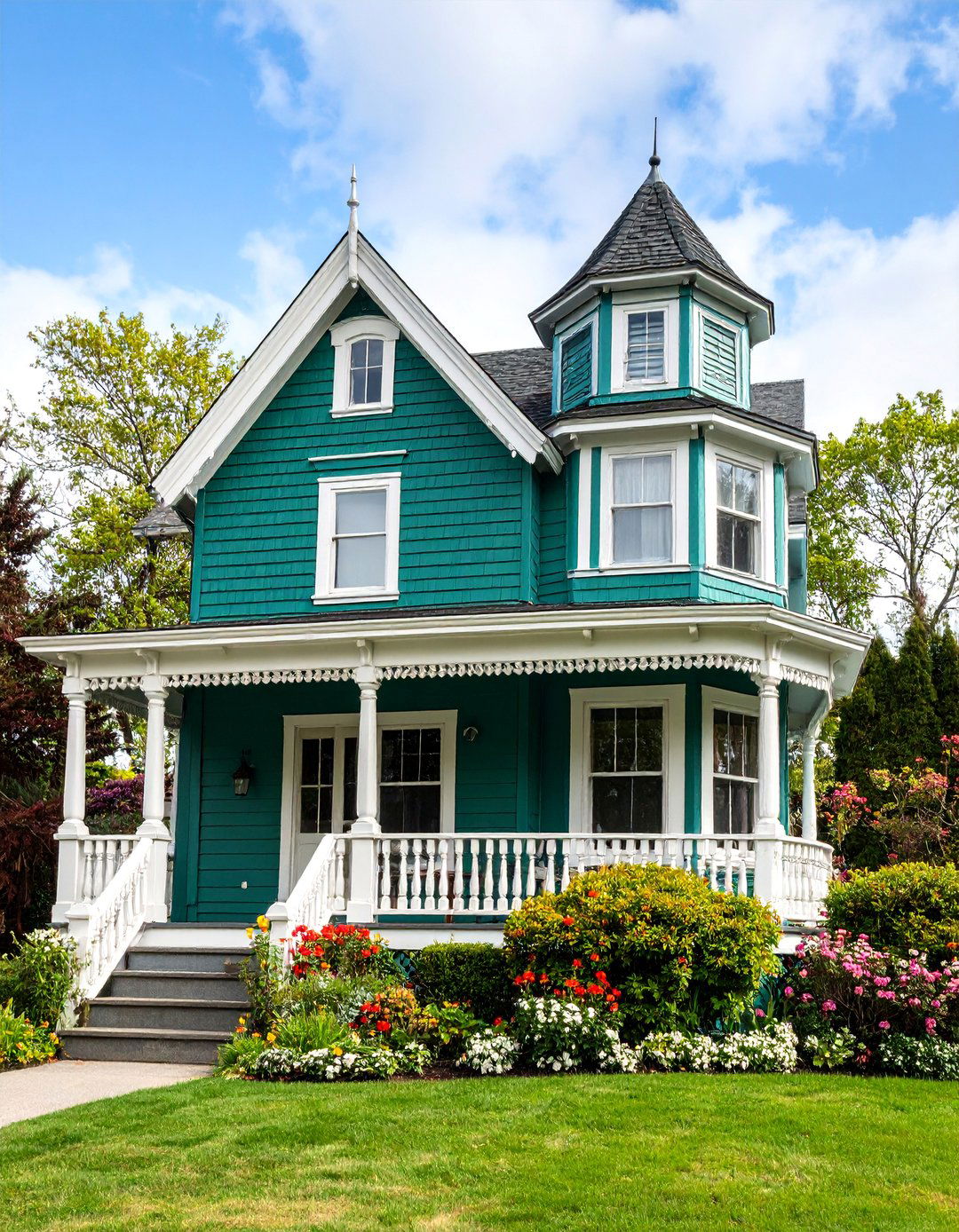
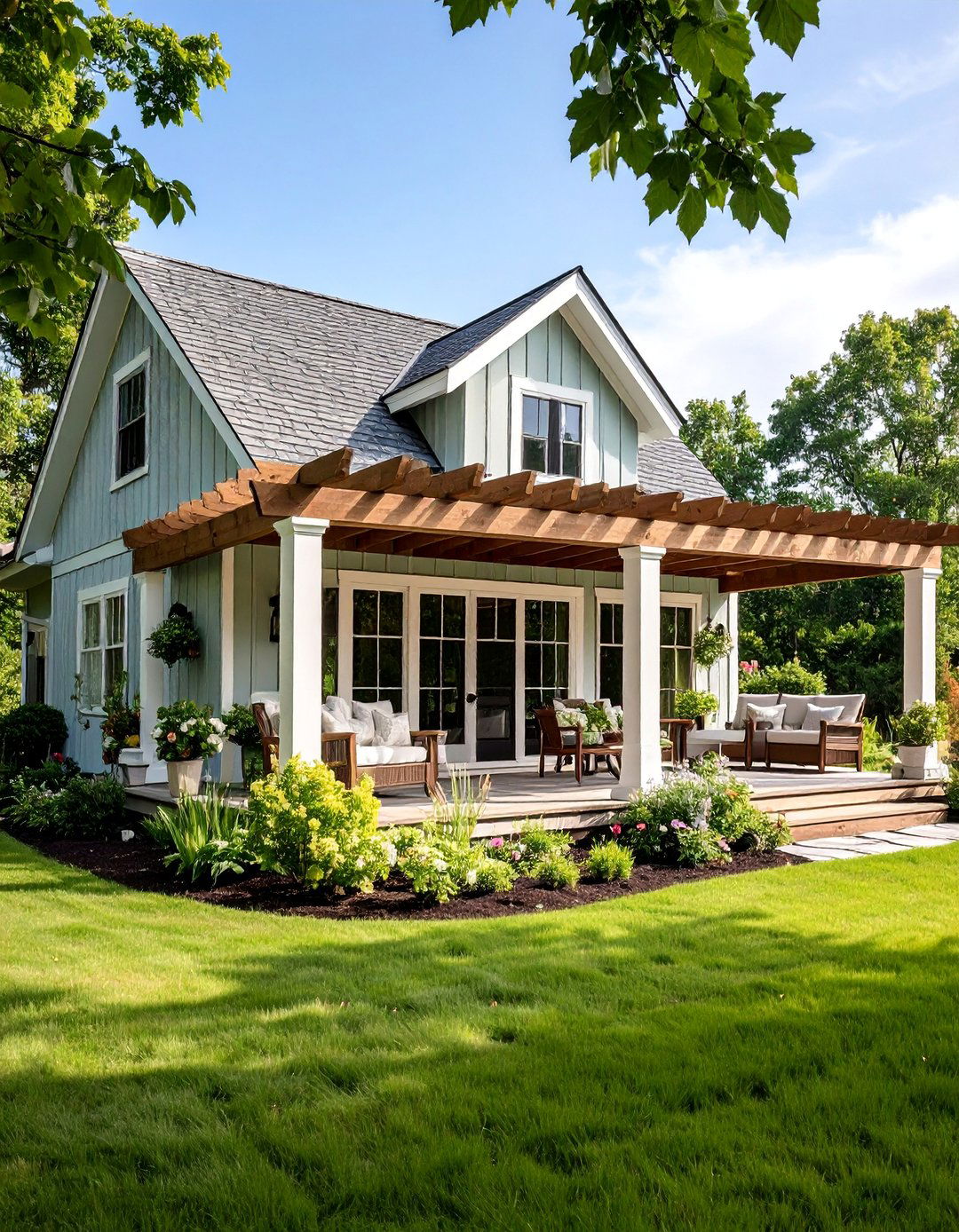
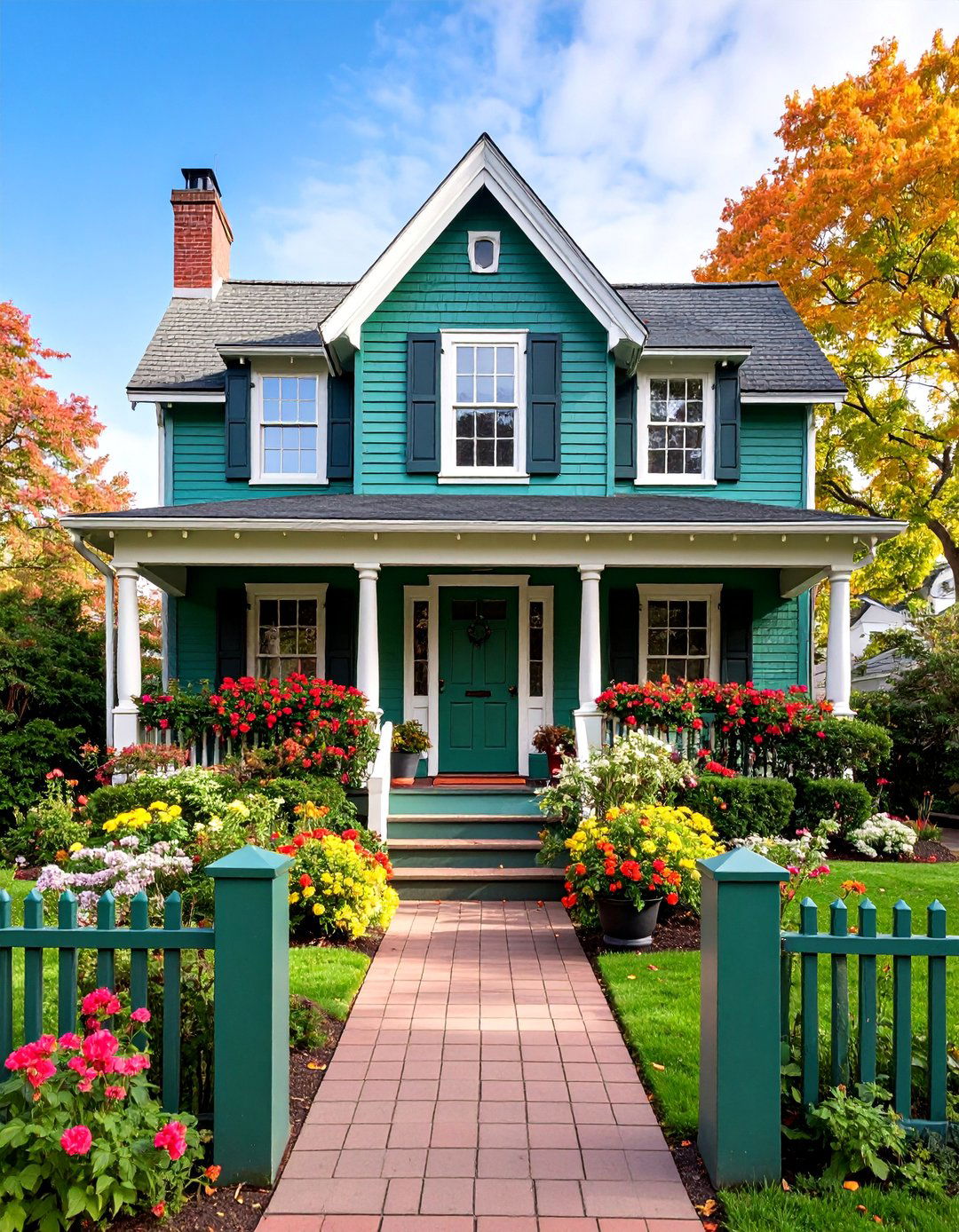

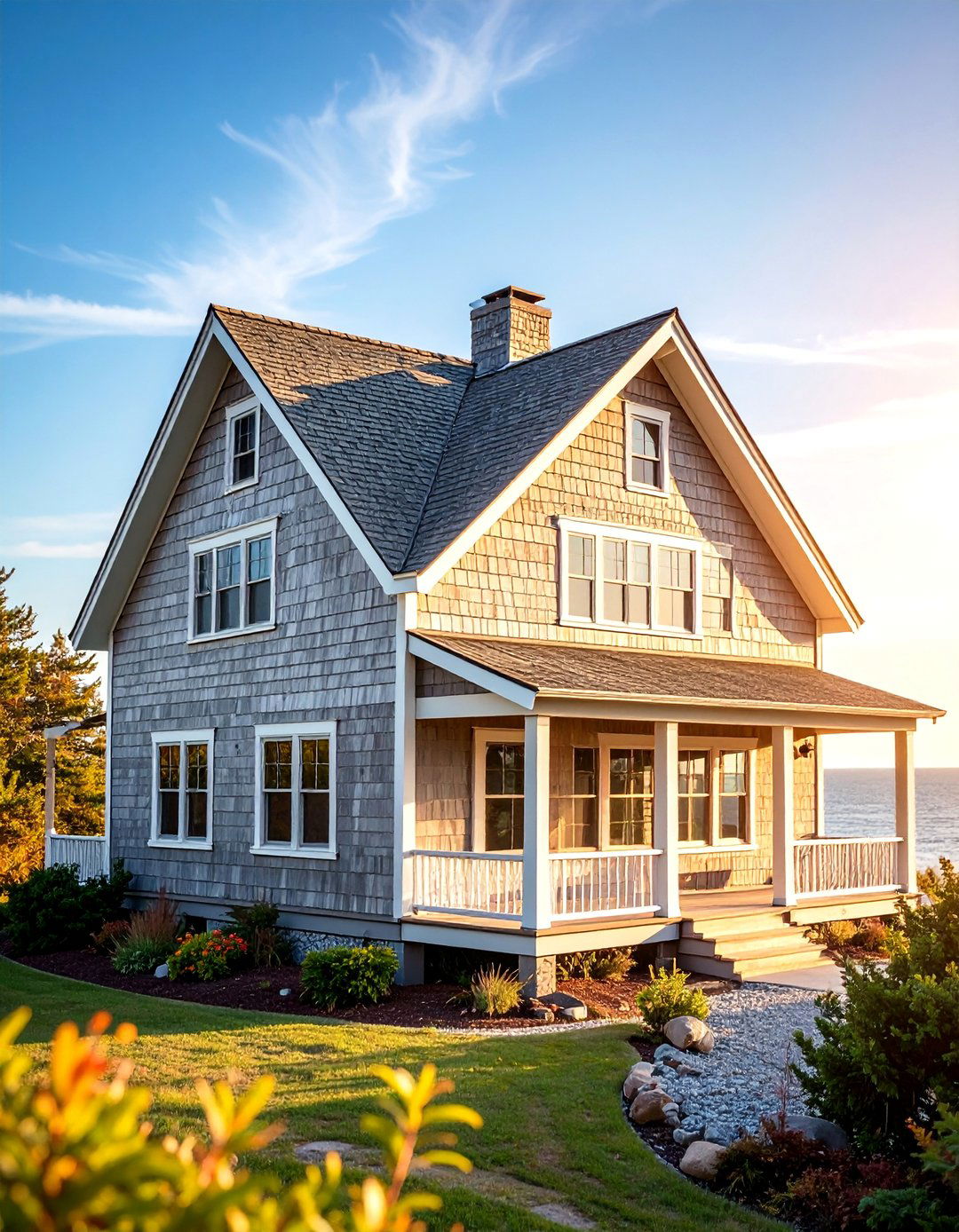
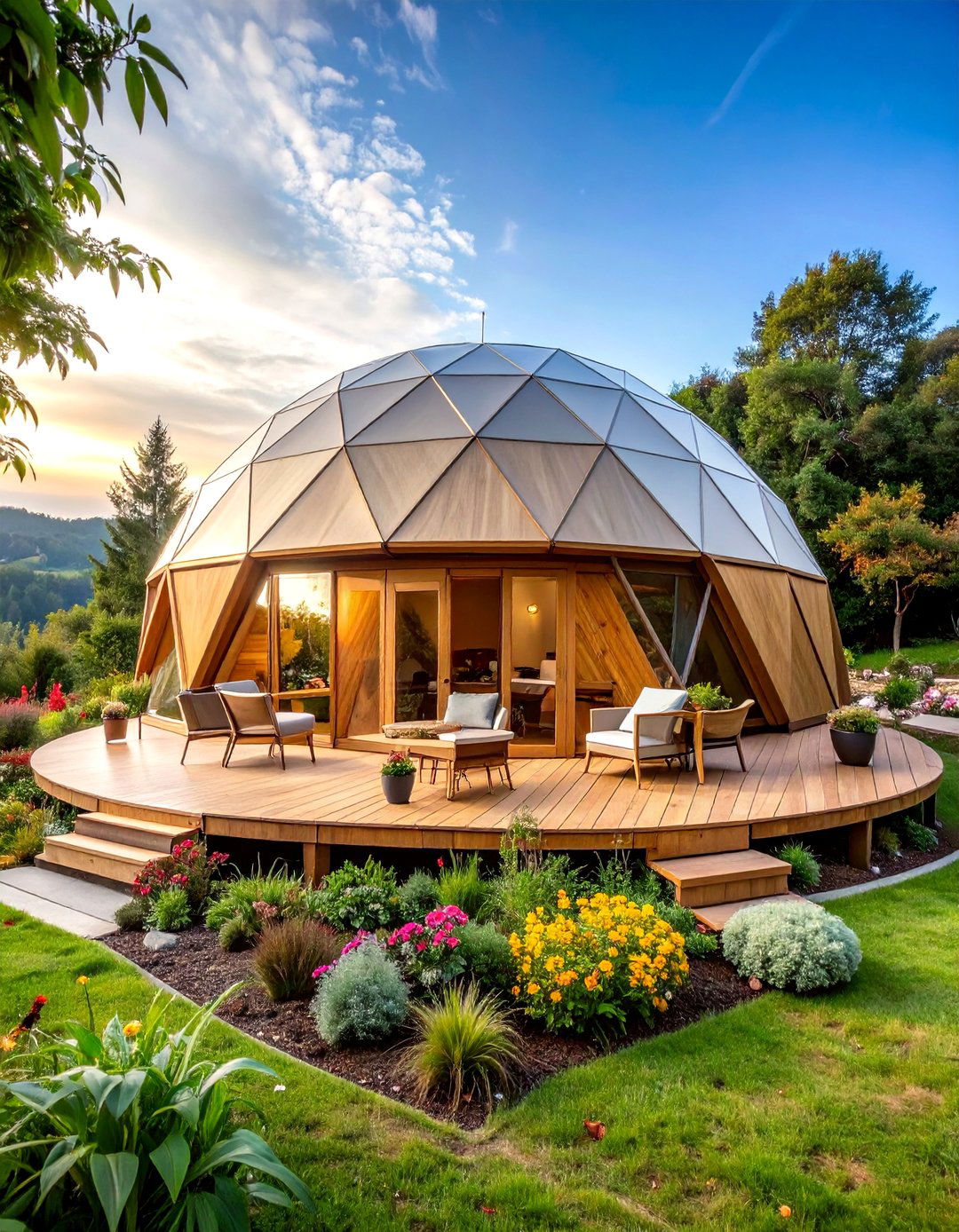
Leave a Reply